Owls and Winter Birding in the Boreal Forest of Minnesota
Go to: USA Birding Tours | Birding Tours in North America | Owls of the World Tours | Tours by destination - List

Dates and Costs:
21 – 26 January 2025
Price: US$2,780 / £2,335 / €2,723 per person sharing
Single Supplement: US$430 / £361 / €421
* Please note that currency conversion is calculated in real-time, therefore is subject to slight change. Please refer back to the base price when making final payments.
Recommended Field Guide
(Please also read our blogs about recommended field guides for the seven continents here )
Tour Details
Duration : 6 days Group Size : 4 – 8 Tour Start : Duluth Tour End : Duluth
Price includes:
Meals Accommodation Transport Guiding fees Park entrance fees Tolls
Price excludes:
All flights Personal insurance Alcoholic beverages Gratuities ( please see our tipping guidelines blog ) Laundry service Personal expenses such as gifts
Featured Guide:

Owls and Winter Birding in the Boreal Forest of Minnesota January 2025
In true winter wonderland fashion, Minnesota offers picturesque scenes of snow-covered evergreens and iced-over lakes. This short Minnesota birding tour focuses on a variety of birds that use Lake Superior and the boreal forest as their winter homes. The famous USA birding location, Sax-Zim Bog , offers an incredible variety of habitats and is undoubtably one of the best places for amazing owls like Great Grey Owl , Northern Hawk-Owl , and Boreal Owl . Of course, the bog features more than just owls with other incredible boreal bird species including Evening Grosbeak , Pine Grosbeak , Ruffed Grouse and Black-backed Woodpecker . After a few days focused at Sax-Zim Bog, the tour moves up the coast of the mighty Lake Superior towards the small town of Grand Marais , stopping at a few birding areas along the way. A run through Superior National Forest , and other nearby state parks on the way north, offers a good chance at spotting Spruce Grouse and Boreal Chickadee . Just north of Grand Marais, the Gunflint Trail is known to hold some irruptive finch species such as Common Redpoll and Red Crossbill , with luck together with less frequent species such as Two-barred (White-winged) Crossbill and tantalizing ones. After scoring these fantastic winter denizens and many more, the tour concludes back in Duluth where folks can thaw out and make their journeys home after another unforgettable experience.
Itinerary (6 days/5 nights)
Day 1. arrival at duluth international airport.
After arrival, if there is time, we will bird around the Duluth area until dinner. We’ll try Canal Park and Wisconsin Point landfill for Glaucous and Iceland Gulls . We might also see the giant Great Black-backed Gull . As the sun begins to set, we will begin our search for the breathtaking Snowy Owl in the Duluth-Superior Harbor . Dinner will taste so much sweeter after a hopefully successful owl search. Then off to our hotel for a good night’s rest before starting our first full day of birding.
Overnight: Duluth
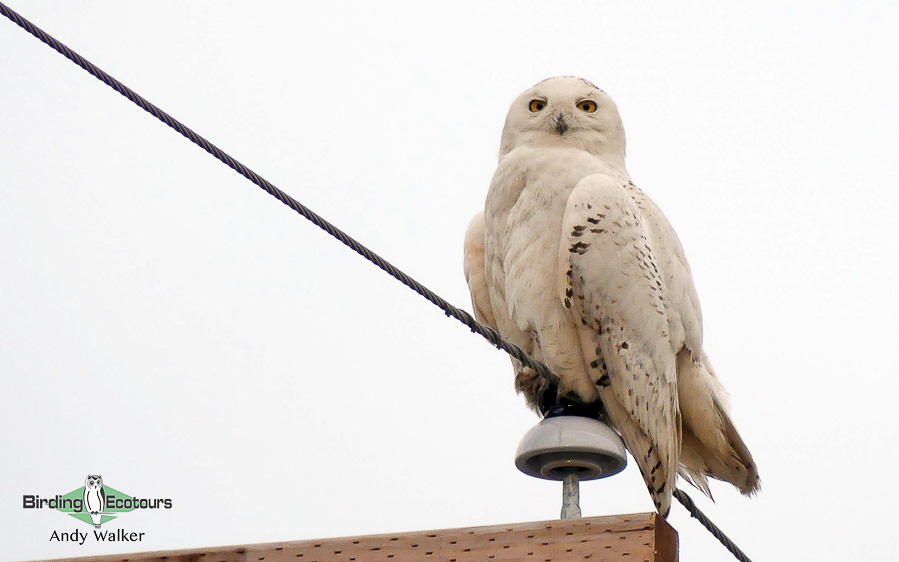
Days 2-3. Birding the famous Sax-Zim Bog Important Bird Area (IBA)
These next two days will focus exclusively on birding the giant area of the Sax-Zim Bog IBA. With its combination of open meadows, aspen and thick evergreen stands, rivers, farmlands, and more, it is no wonder so many boreal species call “the bog” home in the winter. Due to the extremely cold conditions of Minnesota in the winter, we will do most of our birding along the roadsides, never straying too far from the vehicle. We will cruise the roads in the mornings hopeful for a Black-billed Magpie mixed in with the American Crows and Common Ravens .
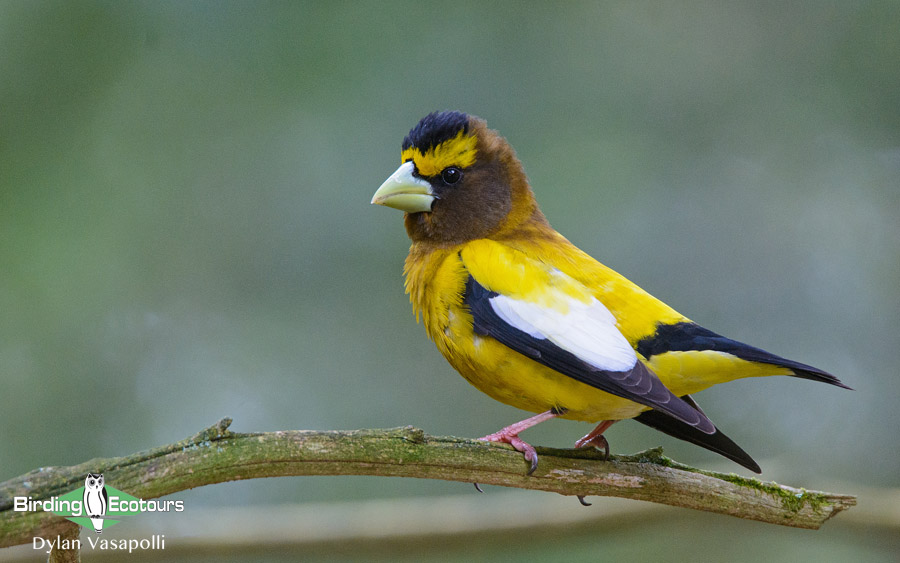
The southern portion of the bog is home to a known Sharp-tailed Grouse lekking area and sometimes these sneaky birds will visit a nearby feeder in the winter. Using various feeder setups throughout the area will be key as several of our targets enjoy the free buffet including Pine and Evening Grosbeaks , Black-capped Chickadee , Canada Jay , and even a hungry Great Grey (Northern) Shrike , from time to time. While driving around this vast area, we will keep our eyes peeled for silhouettes in the empty branches as Ruffed Grouse and North American Porcupines feed and rest. The open meadows play host to a nice variety of diurnal raptors including Bald Eagle , Rough-legged Buzzard (Hawk) and Northern Hawk-Owl . As day turns into evening, the anticipation builds for an appearance of the amazing Great Grey Owl silently hunting the roadsides and snowbanks. We will spend two full days exploring this amazing area which will certainly yield us some fantastic birding.
Overnight: Duluth
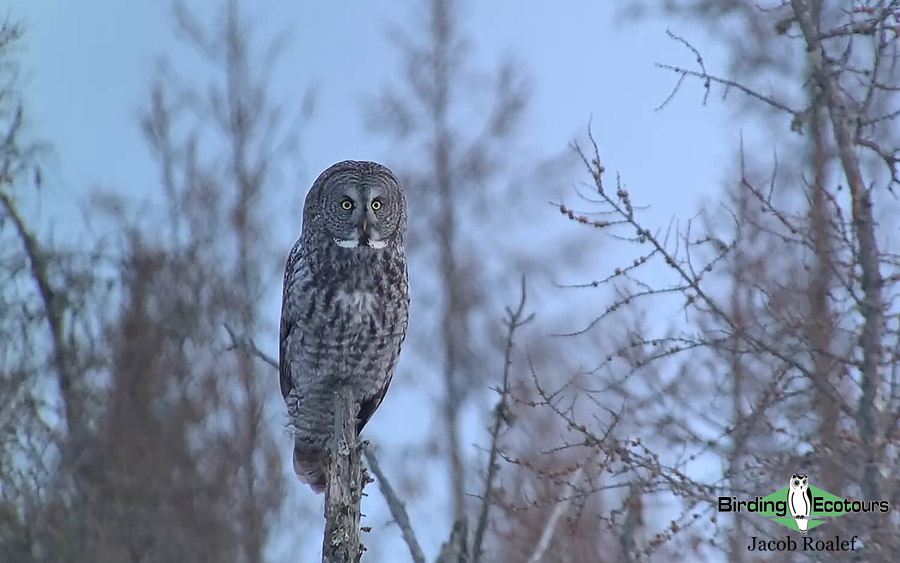
Day 4. Heading north and Superior National Forest
Today we will start our journey north to the small town of Grand Marais with a birding stop in Superior National Forest first. An early morning start will have us slowly patrolling the roadsides, searching for Spruce Grouse , which pick at the roadside grit and salt. As the sun continues to rise, finch flocks of American Goldfinches and Pine Siskins begin their sporadic flights, searching for seed pods. We will continue our birding of the great forest listening and looking for Boreal Chickadees and American Three-toed and Black-backed Woodpeckers . After a nice morning and afternoon of birding, we will arrive in Grand Marais. With our last few hours of light, we will scan the harbor for a potential Long-tailed Duck , Red-breasted Merganser , or Common Goldeneye .
Overnight: Grand Marais
Day 5. The Gunflint Trail and Grand Marais
A National Scenic Byway, the Gunflint Trail, curves its way north through the hills of Superior National Forest and along the edge of the US/Canadian Border. We will enjoy several scenic views along this 57-mile (92-kilometer) road this morning, stopping occasionally at safe pull offs. The far-reaching white pines combined with a bit of altitude make for a finch hotspot including species like Purple Finch , House Finch , Red Crossbill , Two-barred (White-winged) Crossbill and Pine Siskin . The cute Red-breasted Nuthatch and occasional Hairy Woodpecker can be found mixed in with these foraging finch flocks along the trail. The afternoon will be spent birding around the town and campgrounds of Grand Marais for roaming flocks of Cedar and Bohemian Waxwings feeding on the prevalent berries in the area. We will take one last check of the harbor and lake for any waterfowl or gulls we might be missing before calling it a day.
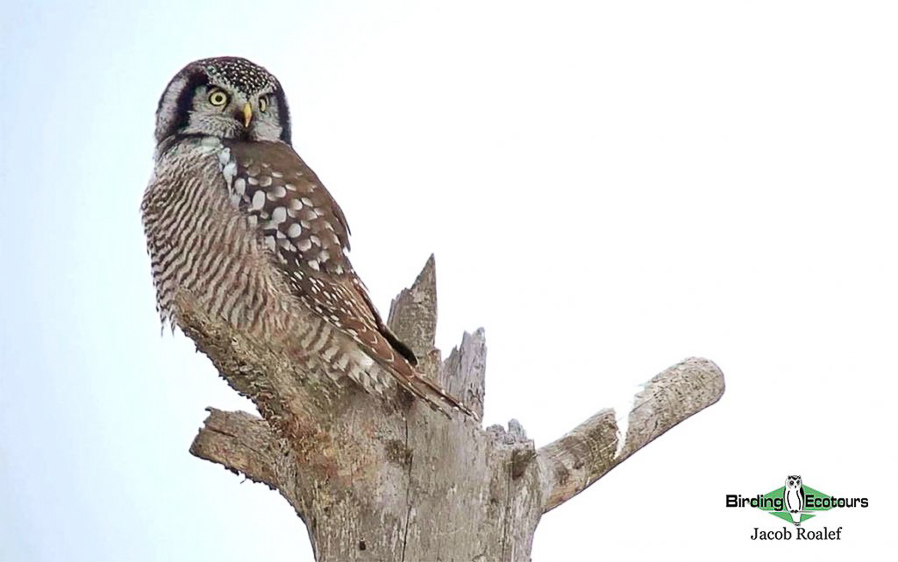
Day 6. Back to Duluth and departure home.
On our final day, we will make the trip south along the Lake Superior shoreline, back to Duluth, to catch our flights home. We recommend getting an afternoon or evening flight if possible. Depending on timing, we may be able to make one or two more birding stops along the way. The tour will conclude with a drop off at the Duluth International Airport .
Please note that the itinerary cannot be guaranteed as it is only a rough guide and can be changed (usually slightly) due to factors such as availability of accommodation, updated information on the state of accommodation, roads, or birding sites, the discretion of the guides and other factors. In addition, we sometimes have to use a different international guide from the one advertised due to tour scheduling.
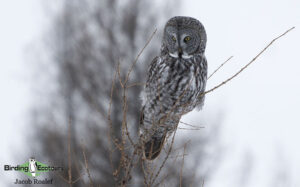
Great Grey Owl
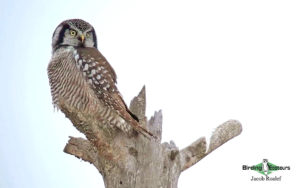
Northern Hawk Owl
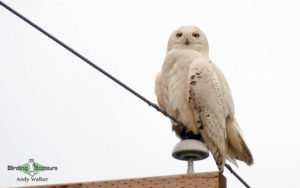
Evening Grosbeak
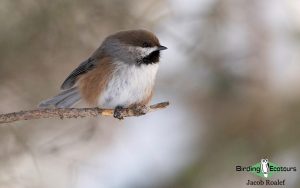
Boreal Chickadee
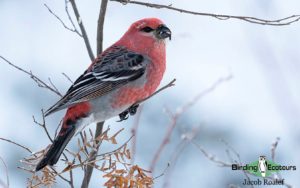
Pine Grosbeak
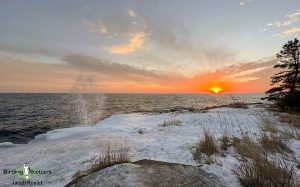
Minnesota sunset
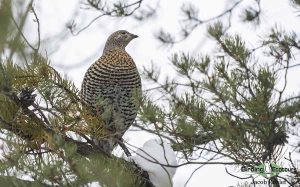
Spruce Grouse
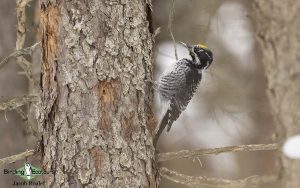
American Three-toed Woodpecker
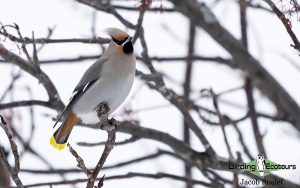
Bohemian Waxwing
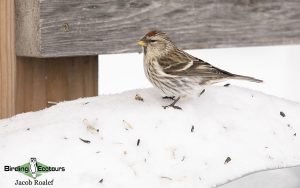
Common Redpoll
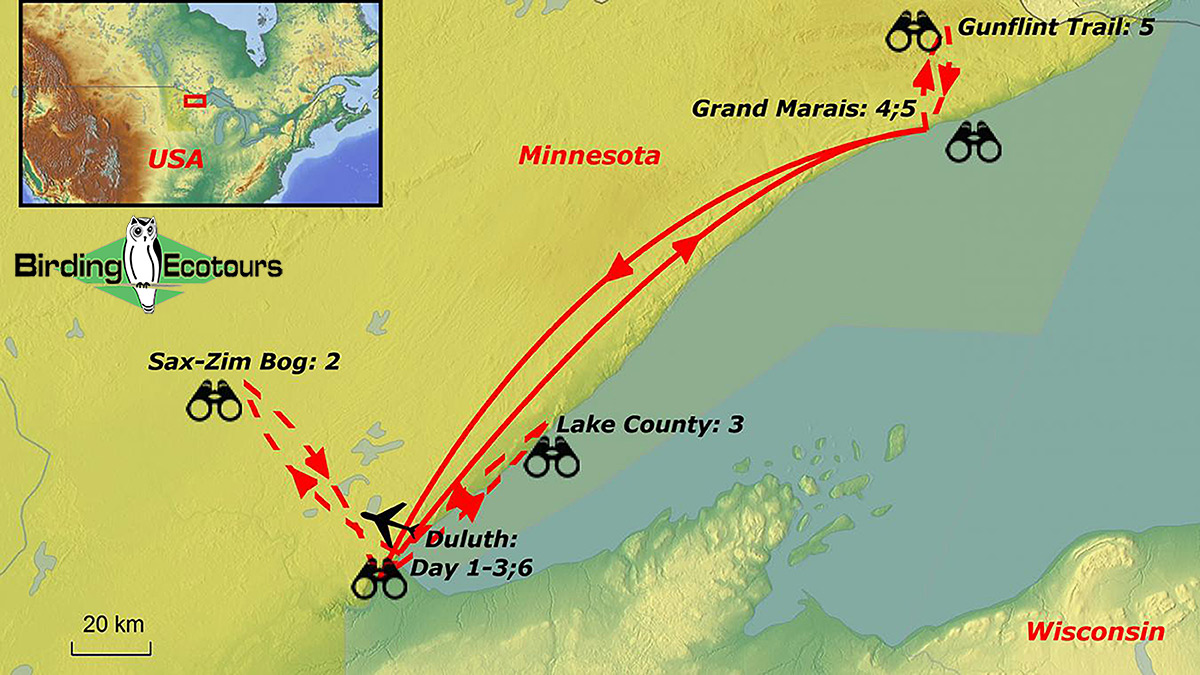
Minnesota: Set Departure Trip Report, January 2024
22 – 27 january 2024, by lucas corneliussen, with jacob roalef.
DOWNLOAD TRIP REPORT
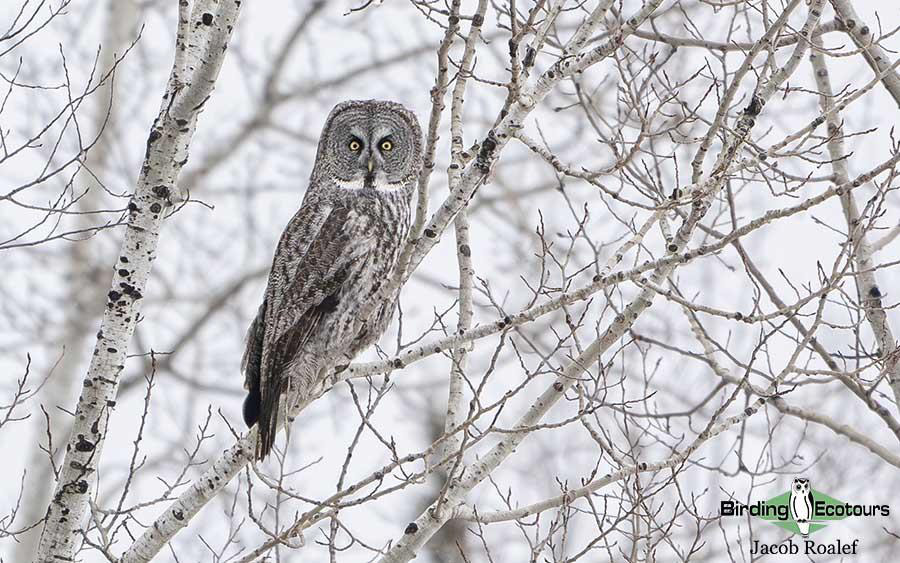
The majestic Great Grey Owl is always a top highlight of this trip!
This year’s six-day trip commenced in Duluth, Minnesota on the 22nd of January 2024, and concluded there on the 27th of January 2024. Unlike most trips, almost all the trip participants arrived ahead of time, allowing for extra birding time on the 22nd. Over the course of the tour, we visited several renowned birding locations, including Sax-Zim Bog, Winterberry Bog, Superior National Forest, and Grand Marais Harbor. We also visited some new locations for the tour including Bowen Lodge and the quiet town of Ely.
Fortunately, this tour was able to locate several of the amazing target birds, yielding a list of very high-quality species despite the low numbers in the region. Avian highlights included Great Grey Owl , Northern Hawk-Owl , Barred Owl , Evening and Pine Grosbeaks , Common Redpoll , Glaucous Gull , Long-tailed Duck , Canada Jay , Ruffed Grouse , Black-billed Magpie , Pileated Woodpecker , Red Crossbill , Snow Bunting , and a breathtaking experience with Bohemian Waxwing and Townsend’s Solitaire . A total of 49 bird species were recorded, along with a few great mammals, including Canada Lynx , Red Squirrel , and White-tailed Deer . The complete trip list, both birds and mammals, can be found below.

This Barred Owl gave some incredible views and even showed off its impressive talon to us.
Detailed Report
Day 1, 22 nd january 2024. sax-zim bog.
Unlike most years, many of the participants arrived in Duluth the day before the trip began. Unfortunately, Ira and Ramona had some issues with their arrival the previous evening, but they were able to take the flight the following day from Minneapolis to Duluth. After dropping off their gear and changing, the group set off for our first stop: Sax-Zim Bog. We arrived at Byrne’s Greenhouse (along Highway 7) and were immediately greeted with a very cooperative Northern Hawk-Owl ! We loaded back into the van and headed down Admiral Road — making a quick stop to see our first Canada Jay of the trip before arriving at the feeder station. Within the first five minutes, a Boreal Chickadee made a fast appearance along with several other species, including Hairy and Downy Woodpeckers , Common Redpolls , and Black-capped Chickadees . By noon, most of us were hungry, so we headed to lunch (Wilbert’s Cafe), but along the way, we found a Great Grey (Northern) Shrike perched high up in a pine along the road.

Northern Hawk-Owl is often seen perched at the apex of an evergreen.
After lunch, we headed to Winterberry Bog and walked along the snow-laden boardwalk. There, we had great experiences with our first Red-breasted Nuthatches , Blue Jays , and American Goldfinches of the trip, and redpolls once again offered spectacular views. Following our walk, we headed west along Arkola Road and hung out at the “hidden feeders,” where another Boreal Chickadee quickly moved through, along with adorable Red Squirrels . After a while, the cold began to set in, so we headed down Owl Avenue to the Sax-Zim Bog Visitor Center, where we spent time watching the Common Redpolls playing in the snow at close range. We then returned to Arkola Road, where six Ruffed Grouse were perched high in a leafless tree. As we continued along the road, BOOM — a Barred Owl nicely sat out in the open, allowing fantastic looks and photo opportunities. Slowly cruising down Highway 7 in the low light, we stumbled across our first gentle giant — the Great Grey Owl . Perched down the track, we watched this magnificent beauty for about 15 minutes before disappearing into the bog’s wooded depths. After a spectacular start to the trip, we drove back to Duluth for a tasty dinner before heading back to the hotel for some much-needed rest.
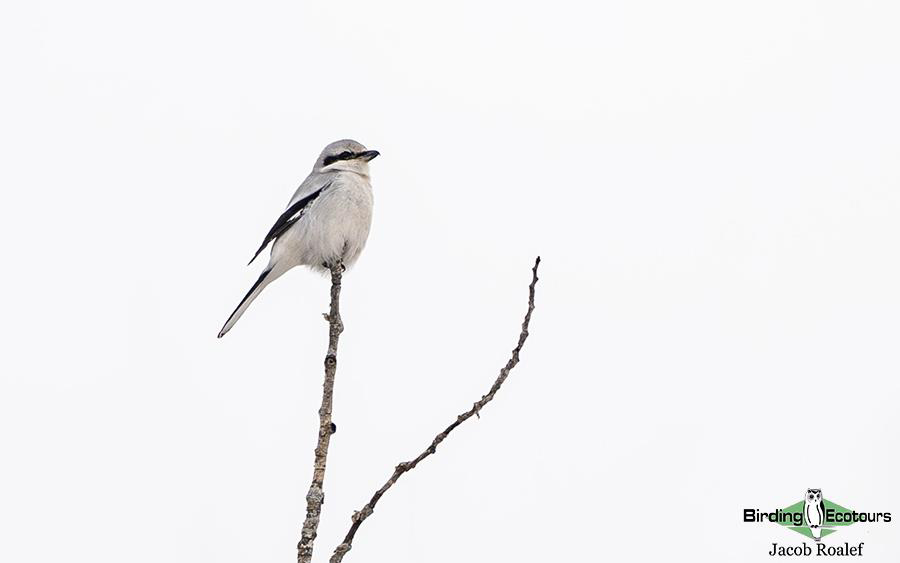
Great Grey (Northern) Shrike was seen on several days throughout Sax-Zim Bog.
Day 2, 23 rd January 2024. More Sax-Zim Bog and the Duluth Waterfront
We departed bright and early for our first morning hours at Sax-Zim Bog. To begin the day, we returned to the area where we had seen the Great Grey Owl the previous evening. Once again, the bird sat atop a snag about 300 feet (~100 meters) down the track. We spent about 45 minutes watching the owl and waiting for it to come closer, but as the day progressed, it opted to head back into its forested home. A fast-flying Snow Bunting rattled as we loaded back into the van. We continued along Highway 7 and found the same Northern Hawk-Owl perched on a distant willow. We spent the next 25 minutes watching the owl and were delighted to witness a Great Grey (Northern) Shrike happily sitting on top of a willow. We continued down Admiral Road again and waited an hour, watching the northerly feeder station. Patiently waiting, we enjoyed the local specials before a pair of Boreal Chickadees joined the feeding frenzy along with a small family group of highly cooperative Canada Jays .
Excited by our success, we headed northwest towards the infamous “Mary Lou’s Feeders.” On the drive, we were surprised to find a nice rafter of Wild Turkeys ! Upon arrival at Mary Lou’s, we were delighted to find several Evening Grosbeaks visiting the feeders, later joined by a group of 30 individuals. We were also excited to see our first Purple Finches and Pine Siskins of the trip feeding on the sunflower seeds.
By noon, we began heading south back towards Duluth for the afternoon. But first, we slowly made our way through the Meadowlands and turned up a single, Black-billed Magpie . It was quite distant, however, and only a few group members could get on it, leaving us desiring better looks. Driving back to Duluth, we stopped for lunch before continuing to the Lake Superior waterfront. We stopped at Canal Park, where we encountered our first American Herring Gulls and Mallards of the trip. Walking along the ice-covered lake — a large flock of Common Goldeneye whizzed by before landing in the only open water in the harbor, allowing for stunning views at close range. Continuing towards the van, WHAM — a Merlin carrying a House Sparrow zoomed by the group and landed in a nearby tree. The whole group marveled as we watched it pull the sparrow apart. It was gruesome but amazing to witness.
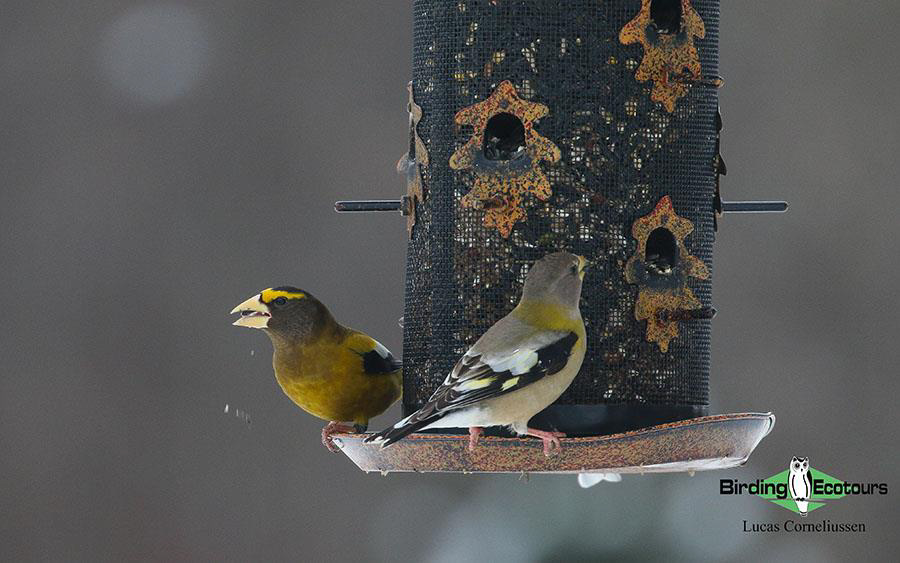
Continuing along the waterfront, we arrived at Park Point and watched the ice fishermen in their tents on the frozen harbor. Walking up the boardwalk toward the beach, we began scoping Lake Superior, and a female Long-tailed Duck flew by and headed west. Unfortunately, only a few could get on the bird, but as we were driving to our final location of the day, we saw a large flock of Mallards clustered together on the frozen lake, joined by several American Black Ducks and a Mallard x American Black Duck hybrid. Arriving at our final location for the day, in fading light, we arrived at Pier B and scoped the large gull flock on the ice flows. Two magnificent juvenile cycle Glaucous Gulls sat within a large flock of American Herring Gulls . One was a first cycle, and the other was a third cycle, allowing for a nice comparison of different age groups. As the daylight diminished, we headed to dinner before returning to the hotel.
Day 3, 24 th January 2024. Sax-Zim Bog Finale and Bowen Lodge
Leaving the hotel a bit earlier than the previous few days, we headed north towards Sax-Zim Bog for our final morning there. After a 40-minute drive from Duluth, we again headed up Highway 7 and located the Great Grey Owl in its usual spot perched atop a snag about 300 feet (~100 meters) down the track. It took off early this morning into the woods and did not offer the group desired views. Driving down McDavitt Road, we stumbled upon our long-awaited nemesis: Black-billed Magpie . It had perched in an open location, allowing for good views of this sleek and majestic corvid. After a successful magpie experience, we headed down Arkola Road and attempted to get one last experience with the deep boreal species. After watching the Arkola Feeders for about half an hour, a male Pine Grosbeak dropped into the feeders and was later joined by a female.
We watched the pair feed on sunflower seeds for nearly ten minutes before returning to the bog. Driving down Owl Avenue on our way to the bathrooms at the visitor center, we stumbled upon what we had been waiting for the entire trip up to this point, a Great Grey Owl at point-blank range. The grey ghost of the boreal forests peacefully sat in a birch tree, carefully watching, and listening to its surroundings. A flutter — bam! The owl quietly departed its perch and pounced on a vole below the tree where it was sitting. Sitting in the snow, it downed the vole in one go before it began walking out into the open on the ground, in its snowy environment. It took off and, just like that, disappeared into the bog as if nothing had happened, leaving the group utterly speechless. Struggling to comprehend fully what we had just witnessed, we continued to the Sax-Zim Bog Visitor Center for a quick look at the feeders before heading west.
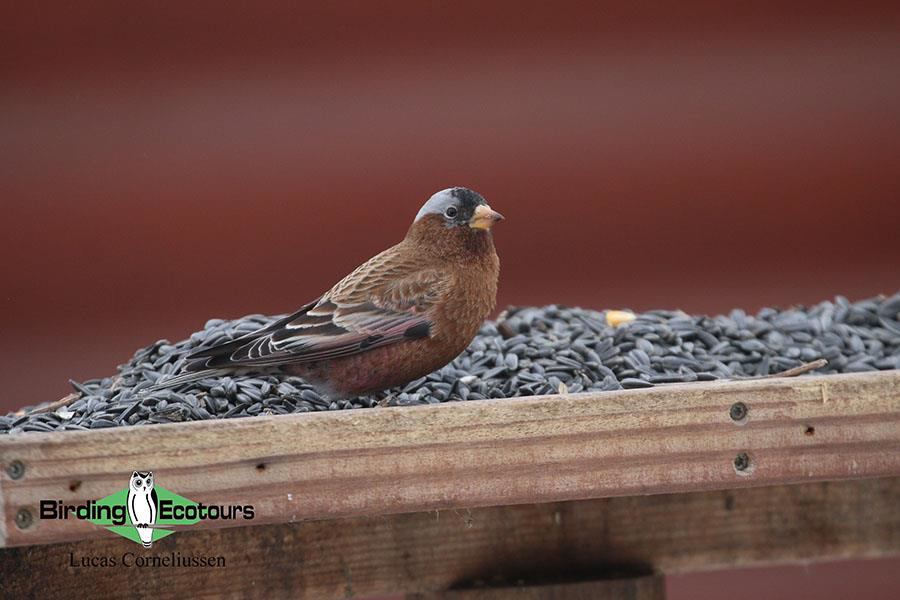
We then began the long drive to Itasca County to search for a reported, Grey-crowned Rosy Finch . After an hour-and-a-half-long drive, we arrived at our destination, Bowen Lodge (Lake Winnibigoshish). Waiting patiently in the cold, watching the local Hairy Woodpeckers feed on the sunflower seeds, a Red-bellied Woodpecker dropped into the feeders. Nearly an hour later, in 24°F (-4°C) temperatures, the Grey-crowned Rosy Finch dropped down from the adjacent Poplar Tree and landed on the seed feeder, allowing for spectacular views at close range. Admiring the rosy finch until it left the feeder, we turned east and began the trek back toward Sax-Zim Bog.
Halfway through the drive, we made a stop for lunch in Deer Park and a stop to take a photo along the headwaters of the Mississippi River. We arrived at Mary Lou’s Feeders in the hopes of relocating some of the same species we had seen the previous day, yet we had little luck in that endeavor. We, however, found our only Mourning Doves of the trip, another rafter of Wild Turkeys , and a small herd of White-tailed Deer . In the fading late, we headed south along McDavitt Road, and suddenly, Debi called out, “Mammal!” We immediately backed up, and standing in the field on the north side of the road was a Canadian Lynx ! It quickly bounded into the woods and did not allow for good looks, but its large grey body and pointed ears made its identity clear. We continued down the road and stumbled upon a beautiful Barred Owl , which unfortunately only allowed for fleeting views before it flew back into the depths of the wooded bog. As the daylight disappeared, we returned to Duluth for some pizza before returning to the hotel for the evening.
Day 4, 25 th January 2024. Woodpecker Day! Plum Creek and Johnson Roads and Grand Marais Waterfront
Despite some less-than-ideal forecasted weather conditions, we headed north toward the Canadian border in search of woodpeckers in northern St. Louis County. We were in search of boreal-specialist woodpeckers. We arrived after an hour’s drive at Plum Creek Road. The dense spruce-covered area appeared perfect for the species we had in mind, and it took us only a short time to find our first target of the day, American Three-toed Woodpecker . This magnificent boreal woodpecker put on quite the show, allowing the group to get fantastic looks and photos at close range. After half an hour, the woodpecker decided it was time to go, and we opted to do the same. Continuing through the boreal zone, we arrived at Johnson Road after a fast half-hour drive. A mix of living and dead spruce trees lined the snow-dusted road, and after walking half a mile down the road, we stumbled into our second target of the day, a male Black-backed Woodpecker . Watching it glean the trunks of the snow-covered spruces, a female joined it, and then a few minutes later, another male joined the group. Enjoying the birds at close range, we watched them for about 15 minutes before disappearing into the dense timberland. The only other bird we saw on Johnson Road was a Northern (Common) Raven .
Famished, we headed to the small town of Ely for lunch. But before we sat down for lunch, we found a Mountain Ash Tree with eight female Pine Grosbeaks ! Sitting down for lunch, we enjoyed the warmth of the café before heading back out to search for trees with berries in town. Despite our best efforts, we could not find any and decided to continue. Driving about an hour down the highway towards Lake Superior, we stopped along Highway 2 and almost immediately located a mixed winter flock, which held a dozen Red Crossbills ! Feeding on the pinecones over 50 feet (15 meters) up, we watched them pick at their meal while being serenaded by the thunderous call of a Pileated Woodpecker . Fifteen minutes later, the crossbills decided it was time to move on, and we did the same. Arriving in Grand Marais near sunset, we spent the last remaining light in the harbor and were pleased to find a small raft of eight Long-tailed Ducks and half a dozen Common Goldeneyes . As the light disappeared, we headed to the hotel to check in and decompress for an hour, before heading to dinner in town for a much-needed meal. Returning to the hotel later that evening, we headed to bed fully fed and ready for another day!
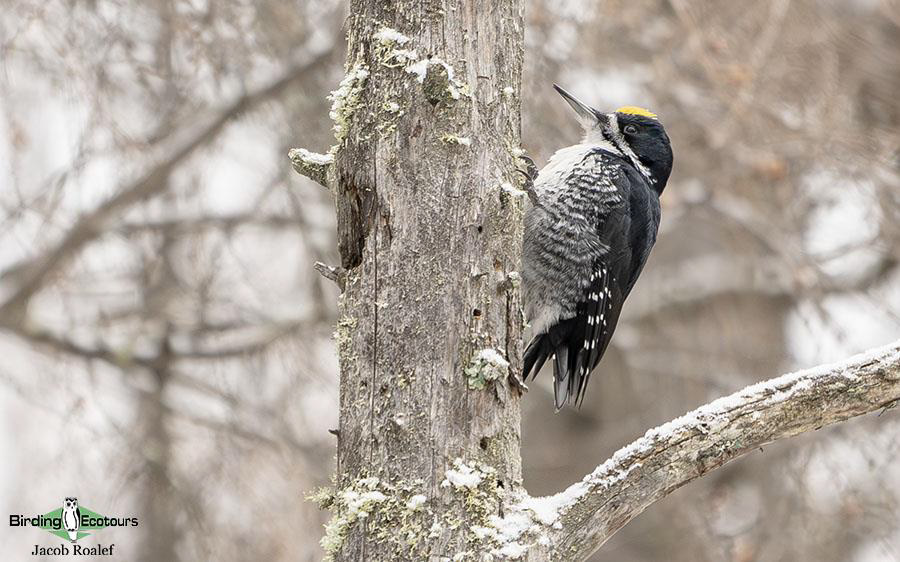
This Black-backed Woodpecker put on quite a show for the group.
Day 5, 26 th January 2024. Gunflint Trail and Grand Marais
Waking up for our final full day of birding with excitement, we ate breakfast at the hotel before driving up the Gunflint Trail into the Superior National Forest. Slowly working our way north, we were enchanted to find the forest: quite literally a winter wonderland. The previous day’s warm temperatures had allowed the tree branches to crystallize in the night, giving the appearance of an icy utopia. Arriving at our first stop after about an hour, we slowly walked along a snow-covered forest road and witnessed the Minnesotan winter in full effect. Watching a pair of Red-breasted Nuthatches make their eerily loud “yenk, yenk, yenk” calls, they made their way toward us, allowing for great looks. We meticulously searched the wintery landscape and came across a small family group of Black-capped Chickadees and a Downy Woodpecker . As we headed back towards the car, it began to snow on us, emphasizing the serenity of the area.
Loading back up in the vans, we continued to head north and stopped at the Trail Center Lodge and Restaurant to see if they had their feeders up this winter; however, we learned they had yet to be put up. As a consolation prize, we walked down the path to Poplar Lake, which had frozen over, and it allowed those brave enough, to walk on it. Heading back to Grand Marais, we continued to cruise the road slowly before arriving in Grand Marais for a quick lunch. After replenishing our appetites, we headed down to the harbor and located a trio of male Red-breasted Mergansers just beyond the jetty, as well as a cluster of American Herring Gulls on the ice. Returning to the neighborhoods we had quickly driven through the previous day, we made our way up 8 th Avenue, and sitting at the very top of a poplar was a flock of over 200 Bohemian Waxwings .
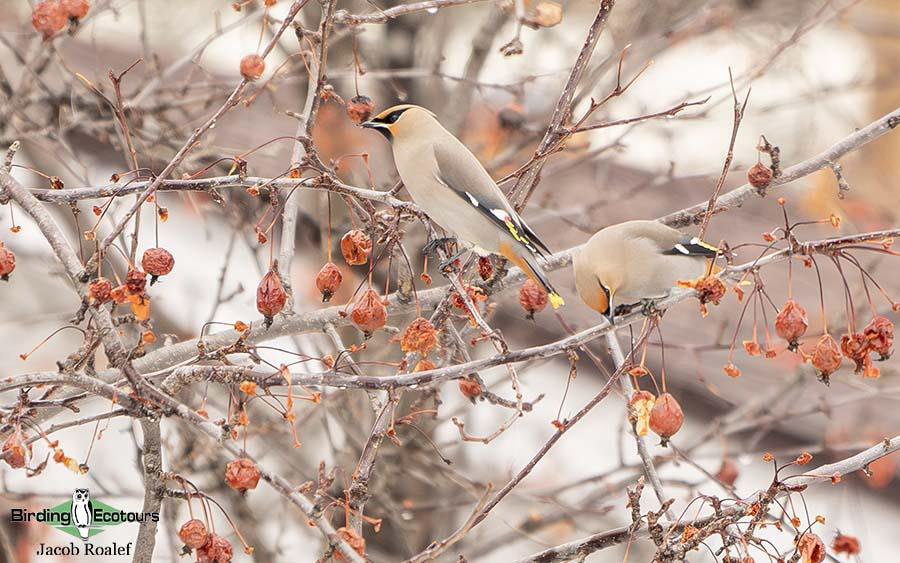
Bohemian Waxwings decimated the berry trees in Grand Marais.
We watched as the flock would rotate from the high poplars down to the low berry tree, some even going down onto the snow. Ten minutes later, we watched as the entire flock departed. During the frenzy of the waxwing spectacle, a Townsend’s Solitaire made a brief appearance, but fortunately, we were eventually able to track it down, a few blocks down the road and got fantastic eye-level views. Heading back down to the icy harbor, we visited the northern section, and as we pulled up, another group of over 50 Bohemian Waxwings were perched up in a poplar in the parking lot. They only stuck around briefly, allowing us to begin scanning north with our scopes. Mary Lou suddenly spotted a large raft of ducks on the horizon. When we brought the scopes over, the entire flock suddenly vanished. Fortunately, they resurfaced, and it turned out to be a massive flock of over 150 Long-tailed Ducks . They had an interesting behavioral trait that led them to simultaneously dive in a synchronous pattern, likely to feed, explaining their sudden disappearance. Unfortunately, they were quite distant and did not allow for close photography. As we continued in the harbor, we turned the corner and found a second flock of 25 Long-tailed Ducks at a much closer range, allowing for much better photography conditions. With a few hours of daylight remaining, we opted to head back up the Gunflint Trail and re-walk the same trail we had done earlier in the day. Despite our best efforts, we could not find anything new, and we headed back to Grand Marais as the daylight faded. We headed back to the hotel for a quick break before heading to our final dinner of the trip. Feeling satisfied, we returned to our beds and rested for our final morning.
Day 6, 27 th January 2024. Departure day and final birding
Our final morning in Minnesota. After eating breakfast at our hotel in Grand Marais, it was time to depart for Duluth for our flights home. Driving back along Lake Superior, we took in the breathtaking views and headed west. We stopped in Two Harbors for gas and restrooms and were delighted to find the Dickcissel , which had been hanging out with the local House Sparrow flock. However, it took a while to re-find it, given that an immature, Sharp-shinned Hawk was eyeing the flock from afar. Pushing further west, we made one last attempt at the dump. We found a flock of ducks in the outflow, which held the only Greater Scaup of the trip among the Mallards and American Black Ducks . We continued to the composting piles and found half a dozen Glaucous Gulls perched atop one of the buildings with the other gulls. Before heading to the airport, we had a quick lunch break and said our goodbyes. We headed to the airport and departed with memories that are certain to last a lifetime!
Bird List – Following IOC (13.2)
Birds ‘heard only’ are marked with (H) after the common name, all other species were seen.
The following notation after species names is used to show conservation status following BirdLife International: CE = Critically Endangered, EN = Endangered, VU = Vulnerable, NT = Near Threatened.
Mammal List
This is a sample trip report. Please email us ( [email protected] ) for more trip reports from this destination.
PREPARING FOR MINNESOTA IN WINTER
A Great Grey Owl descends silently upon an open field to catch a vole hidden in the deep snow. Flocks of colorful winter finches noisily visit a feeder, rivaling even the tanagers of the tropics in color. Grouse strut along an open field with their amazing snowshoe-like feet, perfectly adapted in both form and color to the depths of winter. These are the images that come to mind when one thinks of a birding trip to Minnesota in winter.
Although visiting this frigid state in winter may seem like madness to the uninitiated, the birds that occur in northeastern Minnesota are among some of the most special and charismatic in the world, such as Northern Hawk-Owl, Great Grey Owl, and Snowy Owl. Sitting on the southern edge of the vast boreal forest biome, northeastern Minnesota is the southern limit of distribution for many other boreal forest species that do not regularly occur further south, such as Boreal Chickadee and Grey Jay. However, one must keep in mind that a trip list to this state in January will only include about 40 or so hardy species, with few individuals overall. It will definitely be a case of quality over quantity.
Another factor to consider is the weather. Average high temperatures in Duluth in January range between 15 to 20 degrees Fahrenheit (-9 to -6 degrees Celsius), but it can potentially never go above 0 degrees Fahrenheit (-17 degrees Celsius) on some days. Although it will be very cold by most standards, most of our birding will be done along roadsides, either near or within the warmth of our vehicle. There may be a few very short walks of a couple of hundred meters/yards or less. Notwithstanding these details, please dress in multiple warm layers!
Download General Information Minnesota Download What to bring
‘I thoroughly enjoyed my Minnesota birding tour with Jacob Roalef of Birding Ecotours in January of 2022. The tour was very easy to book, and the ongoing communication with the corporate office and with our guide, Jacob was exceptional. I always got a prompt response to email questions, which was important and reassuring. Jacob was extremely knowledgeable of the local area and the various birding hotspots in order to give us the best opportunity of locating the various species we had all come to see. I would highly recommend this tour!’
Chellye ‘Jacob was patient, funny, talked to all the participants, and made sure all members got on the birds. Jacob gave me good looks at and information on two life birds, Glaucous and Iceland Gulls. He was also an excellent driver, especially on the last day when we drove from Grand Marais in a snowstorm.’ Lynn ‘I had even more fun than I expected on this wonderful winter tour. The bird highlights were varied from chickadees to grouse to owls and the winter scenery along the lake was breathtaking. Jacob is an excellent guide and very knowledgeable about both the area in general and the birds. We had birders of various levels of experience in the group and everyone enjoyed the experience.’ Sherry
‘It was a trip that I liked very much and highly recommended. Jacob’s experience in birds and in the organization of everything made the trip run smoothly. The birds, many of them were new to me which was a delight.’ Susana
‘A great overview of Minnesota winter birding. Although the list of potential birds is somewhat limited because of the weather, the quality of what we did see more than made up for lack of quantity. Eleven of the 44 birds I saw were lifers, including Great Grey Owl, Boreal Chickadee, Pine Grosbeak, Sharp-tailed Grouse and more. Most spectacular was I saw my first Bohemian Waxwing and then about 1,000 more as part of a massive flock, feeding on berries throughout the town of Grand Marais. We were able to experience that over two straight days.’ Gene
All Rights Reserved, Birding Ecotours
Join our newsletter for exclusive discounts and great birding information!
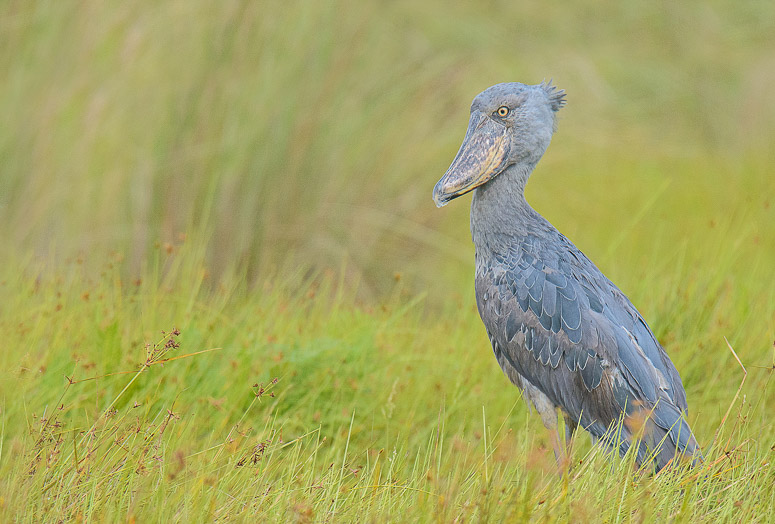

Birding Minnesota
It might get a little chilly... but there will be birrrrrrds....
Northern Minnesota in the winter can be intimidating. Snow can pile up quickly, temperatures drop below zero, and there is barely - if any - cell phone service.
This is what makes Minnesota, and Sax-Zim Bog, one of the greatest birding adventures to be found in the United States. Well, and also the amazing bird species.
The possibility of seeing four incredible owl species - Great Gray Owl, Boreal Owl, Northern Hawk Owl, and the majestic Snowy Owl!

Minnesota Tours
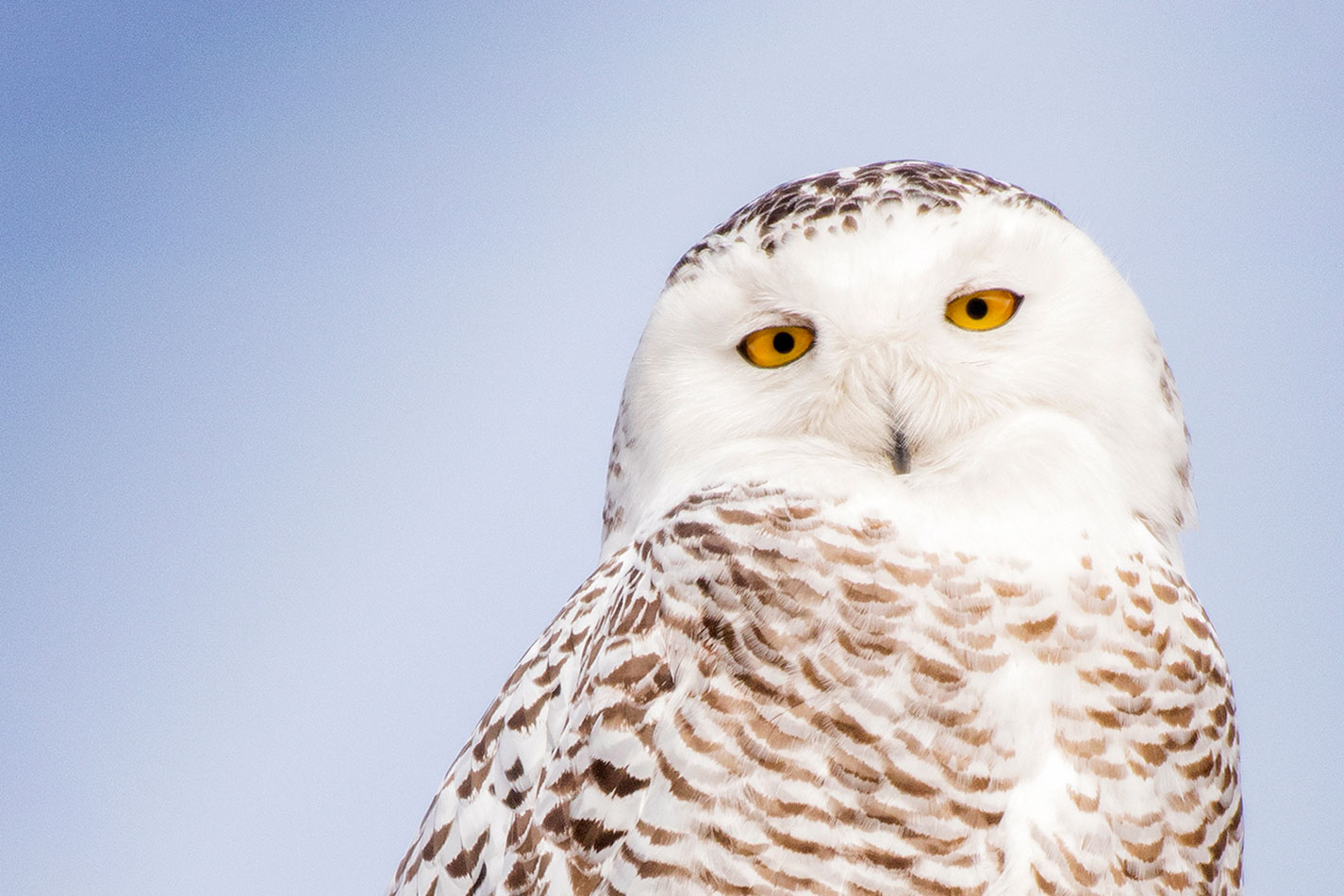
2025 Minnesota – Sax-Zim Bog, Boreal Specialties, and Owls

- Mississippi Flyway
- Prairie and Wetland Conservation
- River Conservation
- Urban Conservation
- News Coverage
- Press Center
- Get Involved
- Support Our Work
- Ways to Help
Birding in Minnesota
At the confluence of three major North American ecotypes – the boreal-hardwood forest, the eastern broadleaf forest, and the prairie parkland – Minnesota has an interesting diversity of birds and places to see them.
Audubon Minnesota has three online birding trail guides to introduce you to these places:
Minnesota River Valley Birding Trail Guide
Great River Birding Trail Guide -- Headwaters to the Minnesota-Iowa Border
North Shore Birding Trail -- Birding Minnesota's North Shore of Lake Superior from Duluth to Grand Portage
Each online interactive map features location details, descriptions and information about the main trail guide you have selected (indicated by numbered icons) and also highlights locations from the companion bird trail guides (indicated by colored dot icons). You'll find a description of all the features available on the first panel of the map tour.
These digital Birding Trail Guides are also accessible and automatically formatted on any mobile device. Happy birding!
Funding for this project was provided by the Minnesota Environment and Natural Resources Trust Fund as recommended by the Legislative‐Citizen Commission on Minnesota Resources (LCCMR).
Help Birds of Conservation Concern
You are what hope looks like to a bird.
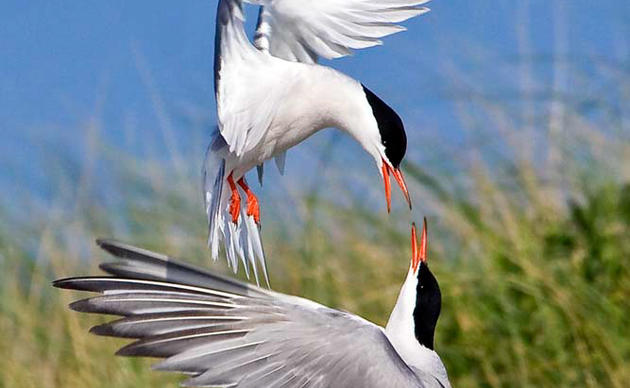
How you can help, right now
Donate to audubon.
Help secure the future for birds at risk from climate change, habitat loss and other threats. Your support will power our science, education, advocacy and on-the-ground conservation efforts.

Ensure a Bright Future for Birds
Minnesota birds need your help today.

YOU can be a community scientist!
You can volunteer with Audubon Minnesota and help support birds.


- Uganda: The Pearl of Africa
- Vietnam: Photography in the Far East
- Australia: Photography Down Under
- Costa Rica: Endemics and Specialties with Black Swamp Bird Observatory
- Costa Rica: Jewels
- Costa Rica: Mountains, Marshes, and Mangroves
- Costa Rica: Quetzal Photography Extravaganza
- Costa Rica: Raptor Migration Spectacular
- Costa Rica: Talamanca and Osa Endemics
- Guatemala: Birding and Culture in the Mayan World
- Guatemala: With Schoodic Institute
- Honduras: Specialties of Northern Central America
- Panama: A Fundraiser with Tucson Audubon Society
- Panama: Canopy Camp
- Panama: Canopy Lodge
- Panama: Canopy Lodge and Tower with Land Sea & Sky
- Panama: Canopy Tower
- Panama: Tropical Islands
- Portugal: Birds & Culture
- Spain: The Best of Iberian Birding in Spring
- Chile and Argentina: Birds and Wine
- Chile: Condors, Penguins, and Albatross with Tucson Audubon Society
- Colombia: Amazon Adventure
- Colombia: Photography from Rainforest to Paramo
- Colombia: Santa Marta and Central Andes
- Ecuador: A Week in Paradise
- Ecuador: Andes and Amazon
- Ecuador: Jocotoco Antpitta, Tumbesian Endemics, and More!
- Peru: Pacific Coast and Andean Endemics
- Alaska, Utqiagvik (Barrow): Top of the World Bird Photography
- Alaska: Bering Sea Photo Adventure
- Alaska: Specialties of the Far North
- Alaska, Nome: A Bird Photographer’s Goldmine
- Arizona: Bird Photography in the Sky Islands
- Arizona: Exploring the Sky Islands
- Arizona: Ladies Only – Spas, Sips, and Specialties
- California: Ladies Only – West Coast Getaway
- Great Lakes: A Spectacle of Bird Migration
- Hawaii: Island Hopping for Endemics
- Kansas Lek Treks Photo Workshop: Prairie Chickens
- Michigan: Photography in a Winter Wonderland
Minnesota: Northwoods Winter Adventure
- North Dakota: Photography on the Prairie
- North Dakota: Prairie Birding at Its Best!
- Pennsylvania: Warbler Photo Mania
- Texas and Louisiana: Migration Madness on the Gulf
- Texas: Birding the Rio Grande Valley
- Texas: Birding the Rio Grande Valley with Schoodic Institute
- Cabin Lake, Oregon Photography Workshop
- California Specialties Photography Workshop
- Coastal California Photography Workshop
- Kentucky Spring Photography Workshop
- South Texas Photography Workshop
- Fundraising Tours
- Custom and Private Tours
- Trip Report Archive
- Virtual Programs
- Land Sea & Sky Optics Deal

January 20 – 25, 2025
Leaves From: Duluth, MN
Participant Minimum: 4 Participant Maximum: 5 Activity Level: Light
Price: $2,499 per person
Double occupancy. Single supplement: $450
This is a birding tour , designed to see as many bird species as possible, with special focus on specialty species.
Northern Minnesota’s Sax Zim Bog draws birders in for a chance to see the highly sought after Great Gray Owl and Northern Hawk Owl. In addition to these amazing owls, several boreal species such a Canada Jay, Sharp-tailed Grouse, Northern Shrike, and Black-backed Woodpecker are present. The irruptive nature of many of the boreal forest finches can allow for very large numbers of Pine Grosbeak, Evening Grosbeak, Common and Hoary Redpolls, Pine Siskin, and both Red and White-winged Crossbills! Outside of the bog, we will have the opportunity to try for some of the other boreal forest birds such as Spruce Grouse, American Three-toed Woodpecker, and Bohemian Waxwing. The easy access to birding Lake Superior can even allow for winter gulls, waterfowl, and Snowy Owls! Many of the songbird species frequent bird feeders, allowing for great photography on the surrounding setting!
The boreal forest is home to many incredible mammal species! Moose, Bobcat, and Snowshoe Hare are possibilities! This trip may not be able to boast the largest trip list, but the quality of species makes up for the quantity. The stunning scenery of the boreal forest in winter in addition to great birds is a combination that will make for an unforgettable trip!

Trip Leaders

- Ground Transportation
- Park Entrance Fees
Not Included
- Passport and Visa Fees
- Alcoholic Beverages
- Personal Items
- Travel Insurance

Birds and More Seen on This Tour
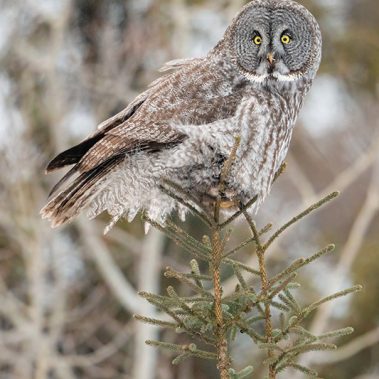
Questions about this tour?
Tour question.
- Tour Select Tour Alaska: Ross's Gull Extravaganza Alaska: Specialties of the Far North Arizona: Exploring the Sky Islands Arizona: Ladies Only - Spas, Sips, and Specialties Belize: An UnBELIZEable Adventure California: Ladies Only - West Coast Getaway California Specialties Photo Workshop California Coastal Photo Workshop Chile: Condors, Penguins, and Albatross with Tucson Audubon Society Chile and Argentina: Birds and Wine Colombia: Amazon Adventure Colombia: Photography from Rainforest to Paramo Colombia: Santa Marta and Central Andes Costa Rica: Endemics and Specialties with Black Swamp Bird Observatory Costa Rica: Jewels Costa Rica: Mountains, Marshes, & Mangroves Costa Rica: Quetzal Photography Extravaganza Costa Rica: Raptor Migration Spectacular Cabin Lake, Oregon Photography Workshop Ecuador: A Week in Paradise Ecuador: Andes and Amazon Ecuador: A Tour with Tucson Audubon Society Ecuador: Jocotoco Antpitta, Tumbesian Endemics, and More! Great Lakes: A Spectacle of Bird Migration Guatemala: Birding and Culture in the Mayan World Guatemala: With Schoodic Institute Hawaii: Island Hopping for Endemics Honduras: Specialties of Northern Central America Kansas Lek Treks Photo Workshop Kentucky Spring Photography Workshop Minnesota: Northwoods Winter Adventure North Dakota: Prairie Birding at Its Best! Panama: A Fundraiser with Tucson Audubon Society Panama: Canopy Camp Panama: Canopy Lodge Panama: Canopy Lodge and Tower Panama: Canopy Tower Panama: Tropical Islands Peru: Pacific Coast and Andean Endemics Portugal: Birds & Culture Spain: The Best of Iberian Birding Texas: Birding the Rio Grande Valley Texas: Birding the Rio Grande Valley with Schoodic Institute Texas and Louisiana: Migration Madness on the Gulf Uganda: The Pearl of Africa Alaska, Utqiagvik (Barrow): Top of the World Bird Photography Alaska: Bering Sea Photo Adventure Alaska, Nome: A Bird Photographer's Goldmine Arizona: Bird Photography in the Sky Islands Australia: Photography Down Under Michigan's UP: Photography in a Winter Wonderland North Dakota: Photography on the Prairie Pennsylvania: Warbler Photo Mania Texas: South Texas Photography Workshop Vietnam: Far East Photography
- Name * First Last
Privacy Overview

Custom and Set-Departure Bird & Wildlife Tours Around the World
Minnesota in winter - birding tour, tour overview:.
Venturing to Minnesota in the heart of the winter months might seem downright crazy to some folks, but when you consider the number of owls, boreal forest specialists, and possible Arctic vagrants that await, it suddenly doesn’t seem nearly as cold. Plus, winter in the “Great White North” has an especially tranquil and invigorating feel, as the landscape is made anew with each passing blanket of snow. Our tour to Minnesota is designed to find as many of these species as possible, as well as experience the world-famous Sax-Zim Bog, a 300 square mile area that includes not only bogs but a wide diversity of woodland habitats that numerous boreal birds call home.

Upcoming Departures:
8 - 13 February ($2560; single supplement: $350)
Ready to Book?
Detailed itinerary, other tour details:.
Length: 6 Days
Starting City: Duluth
Ending City: Duluth
Pace: Moderate
Physical Difficulty: Easy/Moderate
Focus: Birding
Group size: 7 + 1 leader

Day 1: Arrival in Duluth
The tour begins this evening in Duluth, a city on the western tip of Lake Superior. An airport shuttle will be available to our hotel, where we’ll spend the first two nights.
Day 2: Sax-Zim Bog and the Duluth-Superior Harbor
We’ll head out at first light to explore the spruce and tamarack bogs of Sax-Zim. We will begin our search for “the ghost of the
bogs”, Great Gray Owl. This bird can be elusive, but with patience, we usually manage to find one. Northern Goshawk is another top predator for which to keep an eye out. Boreal finches will brighten our day with Pine Grosbeak, Evening Grosbeak, both Common and Hoary Redpolls, and White-winged Crossbill all likely possibilities. We will return to Duluth for lunch, after which we will head out to the Duluth-Superior Harbor where one can usually find Snowy Owls enjoying the winter weather. Gyrfalcons also reside along the harbor some winters.
Day 3: Superior National Forest
Today we will head into the spruce and pine forests of Superior National Forest, north of Duluth. Here our prime target is Spruce Grouse, a specialist that feeds on the needles of spruce and other conifers. We will also search for other boreal specialists such as Black-backed and American Three-toed Woodpeckers, Boreal Chickadee, and Red Crossbills. After lunch in Silver Bay, we will bird our way to the town of Grand Marais for the night, on the north shore of Lake Superior. For the adventurous, we will venture out of town after dinner in hopes of finding the Aurora Borealis (or Northern Lights). This phenomenon is very unpredictable, so we will decide where to go based on information and forecasts available at the time. Those ready to call it a day are welcome to stay at the hotel. We’ll spend a single night in Grand Marais.
Day 4: Grand Marais and the North Shore of Lake Superior
After sleeping in a little and enjoying a hearty breakfast, we will head out to bird the neighborhoods and feeders of Grand Marais, where we hope to find wintering vagrants among the more regular feeder denizens. Varied Thrush and Townsend’s Solitaire have visited in years past. Bohemian Waxwing is also a distinct possibility. After lunch, we will bird our way down the North Shore of Lake Superior back to Duluth, where we spend the final two nights. During the drive, we’ll make stops to check the lake for Harlequin Duck, Long-tailed Duck, and Common Goldeneye, and keep an eye out for Snow Bunting, Northern Shrike, Rough-legged Hawk, and Ruffed Grouse. Of course the real stars of the winter show are the owls. These birds are irruptive, and their abundance fluctuates with prey availability. Some years they are readily found and other years largely absent. On the north shore, we have chances for Northern Hawk Owl, Northern Saw-whet Owl, and Boreal Owl, and will modify our plans as necessary to target any of them that may be around.
Day 5: Flexible Day
We’ll plan this day based on what we still need and what happens to be around and “gettable” during our tour. Possible options include visiting a Sharp-tailed Grouse lek, looking for Black-billed Magpie (here near the eastern limit of their range), spending more time on elusive birds like Northern Hawk Owl, Northern Saw-whet Owl, and Northern Goshawk, looking for Glaucous, Lesser and Greater Black-backed, Iceland, and “Thayer’s” Gulls near the shore (where rarer species like Black-legged Kittiwake, Glaucous-winged, Slaty-backed, and Ivory Gull have also appeared on occasion).
Day 6: Departure
The tour ends this morning, and a shuttle bus is available to take you to the airport.
Trip Considerations
PACE: Moderate. Since it is winter and the latitude is high, the days are short. It doesn’t get light until around 7:30 AM, but we often leave before dawn to reach our destinations by first light. Given the shortness of the days, we do not usually have time to return to the hotel for a mid-day break, but we will have leisurely lunches to relax and warm up. Breakfast is served at the hotel and lunches and dinners are in good restaurants.
PHYSICAL DIFFICULTY: Easy to moderate. With the cold weather, almost all of our birding will be done from or near the car, along roads, or from buildings. We may take some short walks into the snow to search for some specialties, so depending on the snow’s depth, there could be some short, moderately difficult walks of several hundred yards each way. We will, however, generally avoid deep snow whenever possible, and try to keep our outdoor forays to 30 minutes max. Anyone not wishing to do these walks may stay in or near the warm vehicle.
CLIMATE: Usually extremely cold – it is essential to come prepared with suitable winter gear including hand and foot warmers. Be ready for temperatures below 0°F/-18°C, not counting windchill, and on extreme days it can be significantly colder, though this is unusual. On rare occasions, warm and balmy highs of 30 to 40°F (-1 to 5°C) do occur, but don’t expect this. Moderate wind is also a reality on the North Shore of Lake Superior and can make the apparent temperature seem much colder. Snow is possible throughout the tour.
ACCOMMODATION: Very good to excellent. We typically use well-known and respected hotel chains such as Best Western. All of the hotels have typical amenities, including Wi-Fi.
PHOTOGRAPHY: While this is a birding tour, Minnesota in winter offers many opportunities for taking excellent photos of most target species, from Gray Gray and other owls to Spruce Grouse, and winter finches coming into the feeders. Because the list of target species is low, we often spend more time with individual birds, so this trip is more “photographer-friendly” than average.

Other Information
TRAVEL REQUIREMENTS: For US citizens, no special requirements are necessary to visit Minnesota. Citizens of Canada may enter the US with a valid passport, and do not need to obtain a visa. For citizens of the 38 countries on the visa waiver list (including the UK, Western Europe, Australia, New Zealand, Chile, and Japan – click here for the full list ), you can enter the US with a valid passport and a completed Electronic System for Travel Authorization (ESTA), which should be applied for online IN ADVANCE OF THE TOUR. For all passports, the passport must be valid for at least six months past your intended stay. Citizens of all other countries will need to apply for a US visa. Travel requirements are subject to change; please double check with the nearest embassy or consulate, or ask our office staff if you are unsure.
WHAT’S INCLUDED?: Accommodation from the night of day 1 to the night day 5; meals from dinner on day 1 (unless you arrive too late for dinner service) to breakfast on day 6; reasonable non-alcoholic beverages with meals; safe drinking water only between meals (tap water is safe to drink in the US, and you are encouraged to fill your water bottles when able); Tropical Birding tour leader with scope and audio playback gear from the evening of day 1 to approximately noon of day 6; ground transport for the group in a suitable vehicle driven by the guide from the morning of day 2 to approximately noon of day 6; airport shuttle bus on day 1 and day 6; tips for included meals; entrance fees to the sites mentioned in the itinerary; a printed and bound checklist to keep track of your sightings (given to you at the start of the tour – only electronic copies can be provided in advance).
WHAT’S NOT INCLUDED?: Optional tips to the tour leader; tips to baggage carriers if you require their services; flights; snacks; additional drinks apart from those included; alcoholic beverages; travel insurance; excursions not included in the tour itinerary; extras in hotels such as laundry service, minibar, room service, telephone calls, and personal items; medical fees; other items or services not specifically mentioned as being included.
Tour Reviews
*Participated on this Tour? Leave a Review! We would also love to see your favorite photo, upload it!

Minnesota’s Lake Superior Shore & Boundary Waters
September 7 - 14, 2021, w/Wisconsin's Apostle Islands extension
- Full Itinerary
- Photo Gallery
Travel Details
- Trip Reports
- Know Before You Go
Join us for an extraordinary immersion in North Woods nature timed for the first hints of fall color and fall songbird migration. Discover boreal birds, search for iconic northern species such as Common Loon, Moose and Beaver, canoe and explore in the Boundary Waters Wilderness, and survey the shores of Lake Superior—its grandeur and history. This journey is a Sampler tour with a nice blend of birding with other activities including hiking, canoeing, sightseeing and learning local history and geology. We recognize that this is your vacation, so staying back at the Lodge to enjoy the fire or a quiet walk or paddle is certainly an option. While time at lovely Gunflint Lodge at the edge of the Boundary Waters Canoe Area Wilderness is for most the trip highlight, exploring Lake Superior’s exquisite coastline is also memorable—pebble beaches, historic lighthouses, quiet coves, lush forests and beaches are all a delight. And, we begin and end in Duluth where a world-class raptor and songbird migration is underway. We highly recommend you start your trip from here with our pre-tour extension to neighboring Wisconsin’s Apostle Islands. Better yet, join our Isle Royale trip in Michigan and make a grand sweep of the states surrounding Lake Superior.
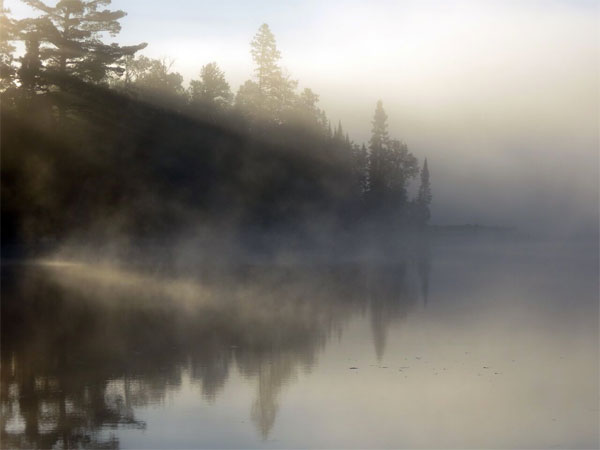
Tour Highlights
- Relax in cozy lodgings at the edge of the Boundary Waters
- Enjoy vistas along Lake Superior, the world's largest freshwater lake
- Explore the Boundary Waters on a canoe excursion
- Witness some of the fabulous waterfalls and cascades that feed Lake Superior
- Visit the artsy harbor town of Grand Marais
- Learn about Ojibwa culture and Voyageur history at Grand Portage National Monument
- Marvel at migrating raptors soaring over Hawk Ridge

Trip Itinerary
Itineraries are guidelines; variations in itinerary may occur to account for weather, road conditions, closures, etc. and to maximize your experience.

Tues., Sept. 7: Arrive in Duluth | Hawk Watching
Please plan to arrive to Duluth, Minnesota today. If you also book our Apostle Islands extension, you will arrive in Duluth to start on September 3, then be back in Duluth to start in with some fabulous birding. Those flying should arrive at Duluth International Airport (DLH). For those that plan on hawk watching, arrive no later than 2:00 PM; we will coordinate pick-ups after we receive flight information from everyone. Those arriving afterwards, please plan to taxi to our waterfront hotel. We drive right up to Hawk Ridge (between the airport and our hotel) to get a quick read on how raptor migration is going; this is the time for Sharp-shinned and Broad-winged Hawks to be pouring through in the late afternoon. We then check into our hotel?with views of Lake Superior?before heading to a favorite local restaurant for dinner. Accommodations at the Hampton Inn, Duluth (D)

Wed., Sept. 8: North Shore Scenic Drive | Gooseberry Falls | Tettegouche State Park
After breakfast at our hotel we drive north along the scenic Lake Superior shoreline. We make stops along the shore to enjoy Lake Superior views, do some rock-hounding, and scan for migrating warblers and raptors at the various stops and overlooks. The shoreline consists of high rocky outcroppings in some areas, and smooth rocky beaches in others. There are several stops with lovely cascades and waterfalls descending to the lakeshore. We stop at Two Harbors to see the historic lighthouse and marina, and both there and in Grand Marais we look for mergansers and ducks at the waterfront. A great walk to a viewpoint lets us stretch our legs at Tettegouche State Park. Enjoy some free time in Grand Marias where tempting shops, an ice-cream or a cold brew at the local pub might entice you. We continue to our historic and delightful lodgings at Naniboujou Lodge. The birding is wonderful here with many Cedar Waxwing feeding on berries, good shrubbery to attract flocks of Black-capped Chickadees and migrant warblers, and a small pond just down the way home to Belted Kingfisher, Spotted Sandpiper and sometimes herons or other waders. Dinner this evening is at our lodge. The Lodge opened in 1927 and was originally a private club. Probably the most memorable aspect of the Lodge is the wondrously painted dining room. Cree Indian designs cover the walls and the 20-foot-high domed ceiling (resembling the shape of a canoe). Guests marvel at its originality. The almost psychedelic Cree Indian designs covering the walls and ceiling are like a North Woods Sistine Chapel. This work of art continually amazes and intrigues, echoing the elegance and style of another era. While the dining room is absolutely stunning, the food is great too! Accommodations at Naniboujou Lodge (B,L,D)

Thurs., Sept. 9: Naniboujou Lodge | Grand Portage National Monument | Pigeon Falls
Meet your guides on the expansive lawn that leads down to the lakeshore for some early optional birding. We enjoy a scrumptious breakfast in the lodge dining room. Then, we head up the shore of Lake Superior, which seems to get only wilder and more lovely as we approach the Canadian border. We want time to walk and bird at Pigeon Falls, the highest falls in Minnesota. Our main destination is Grand Portage National Monument, a mere five miles from the Canadian border. We spend the afternoon exploring the history of the Ojibwa people and the North West Company of the North American fur trade at Grand Portage National Monument. We take in the sights and smells of a bustling depot reconstructed over its original footprint. Each building is staffed by knowledgeable employees dressed in clothing of the late 1700s, performing activities needed by the North West Company. Canoe building, carpentry, making bread, working with flintlock muskets, gardening, crafting baskets, and carving paddles were just some of the activities necessary to make the North West Company one of the most successful companies during the fur trade era. There are films and a bookstore and trails, and plenty of history and nature to absorb. Tonight we dine back at our Lodge. Enjoy the night skies and sounds of Lake Superior lapping on the shore. Accommodations at Naniboujou Lodge (B,L,D)

Fri., Sept. 10: Gunflint Trail | Chik-Wauk Museum | Dinner at Gunflint Lodge
Today we explore the length of Minnesota’s famous Gunflint Trail. Turning west at Grand Marais, we plunge into more and more remote country—a mosaic of meadows, ponds, forests and burn areas from the large 2007 fire, now recovering. Before our lodge, but almost at the very end of the “trail” (which is really a road that ends in the wilderness near the Canadian border), we stop at Chik-Wauk Museum and Nature Center, an historic lodge on beautiful Saganaga Lake. The center presents the area's cultural and natural history through interpretive and interactive exhibits. Learn about the prehistoric beginnings and people who helped shape today’s unique rural community, including Native Americans, Voyageurs, miners, loggers, resort owners, and current residents. We spend some time here looking at the exhibits and hiking and birding. We can walk a loop trail of several hours duration at a leisurely pace to take it all in. Afterwards we head back down the trail, with time to check into our accommodations at historic Gunflint Lodge. We enjoy a great dinner in Justine’s at Gunflint Lodge, complete with views of the lake. Accommodations at Gunflint Lodge (B,L,D)

Sat., Sept. 11 & Sun., Sept. 12: Boundary Water Canoe Area Wilderness Paddling | Birding and Nature Excursions—Two Full Days with Options!
Gunflint Lodge offers a number of excursions with naturalist guides and you will have choices during our stay here. There are full day paddles, and gentle “birding” or “geology of fire and ice” paddles. There are walks with themes on many topics from geology to local history—even a talk on Lake Superior Ghost stories. We can book a sunset cruise or paddle, and learn about local history on a pontoon boat ride. We do encourage you to head out in canoes or kayaks with a guide to explore the area from a different vantage point. The Boundary Waters Wilderness is a unique area of over 1-million acres located in northeastern Minnesota. Retreating glaciers left behind rugged cliffs and crags, canyons, gentle hills, towering rock formations, rocky shores, sandy beaches, and several thousand lakes and streams, interspersed with islands and surrounded by forest. We’re far from big-city life, and after a few hours on the water you gain a sense of clarity and peace. If paddling is just not your thing, you’ve landed in a fine spot to relax, bird the grounds, take a leisurely walk. The lodge is famous for fishing, so if anyone wants to hire a guide and pursue that challenge—it’s possible. A treat here is the food! There is a strong emphasis on local foods, and traditional foods of the North Country. You will find creative dishes with walleye, wild berries, wild rice, maple syrup and mushrooms. The Gunflint Lodge experience is savored by regular guests, and we treasure our three nights here! Accommodations at Gunflint Lodge (B,L,D both days)

Mon., Sept. 13: Return to Duluth | Cascade Falls | Hawk Ridge | Dinner at New Scenic Café
Today we enjoy breakfast at the lodge (blueberry buttermilk pancakes anyone?), then pack up and head back to Duluth, with stops along the way. We have time for some hiking and exploring. First we stop at Cascade River State Park. Dropping 900 feet in the lower three miles, Cascade River takes a steep final run in the last quarter mile as it drops 120 feet through a deep, churning gorge. It is a beautiful and exhilarating sight! We enjoy a picnic lunch at Cascade Park, a beautiful spot right on the shore of Lake Superior. From here it’s an easy drive into Duluth and we plan to arrive with time for those that wish to pop up to check the hawk migration activity at Hawk Ridge. We return to our same Lake Superior shoreline hotel, so if you have driven you can park there, or if you wish store some items while we are north. For dinner we retrace our steps about a half hour up the scenic shoreline, because we so love the dining experience of the New Scenic Café. We can’t think of a better spot to host the farewell dinner, recount our favorite moments, and tally up our final species list. Accommodations at the Hampton Inn, Duluth (B,L,D)

Tues., Sept. 14: Departures from Duluth
Our great North Country adventure comes to an end. Until the next adventure. Please plan departures at your leisure today on flights from the local airport. (B)
Wisconsin's Apostle Islands Pre-Tour Extension
Fri., sept. 3: our pre-tour extension begins.
If you are coming to Minnesota, why not add to your trip and do a little exploring with us—heading east from Duluth to visit the Lake Superior shoreline areas of neighboring Wisconsin with a boat trip out to the Apostle Islands and the Lake Superior shore of Wisconsin. This is new terrain for Naturalist Journeys, recently scouted by guide David Mehlman. Some of the group will come over from our Michigan Isle Royale tour—our plan is to meet up as a group in Bayfield, Wisconsin to explore several areas that have good birding, natural history, and some hiking. Bayfield is the jumping off point for our Apostle Islands visit. Please arrive in Duluth no later than 2PM as it is about a two-hour drive to Bayfield and we may make some stops on the way. We then have time to settle into our hotel and freshen up before we meet for dinner and discuss plans for the next day. Accommodations at the Bayfield Inn, Bayfield (B,L,D)
Sat., Sept. 4: Bayfield | Apostle Islands
For those interested, we’ll have an early breakfast and depart for a short hike and birding trip at the nearby Bayfield Fish Hatchery; those who want to sleep in can have breakfast at their leisure. If the weather permits, we will then head to the nearby boat dock for our 10:00am, 3-hour boat tour of the Apostle Islands. The Islands are Wisconsin’s “crown jewels” and we see lighthouses, sea caves, stunning natural scenery, and plenty of wildlife. Returning from the boat tour, we will undoubtedly be hungry, so we head for lunch at a nearby restaurant. After lunch and a brief break, we reconvene for an afternoon outing at the Meyers Beach Sea Cave Trail in the Apostle Islands National Lakeshore. The hike is about 4.5 miles and we’ll have a chance to explore at close-range the sea caves from the land side, as well as hope to catch some of the fall bird and insect migration. We return to our hotel in Bayfield at the end of the day and meet to discuss the day’s adventures and have dinner. Accommodations at the Bayfield Inn, Bayfield (B,L,D)
Sun., Sept. 5: Wisconsin Lake Superior Shore
The schedule for today depends on whether we were able to take the boat trip the previous day. If not, we’ll try again at 10:00am. If we were successful at the boat tour, after breakfast, we spend the day exploring other sites along the Wisconsin shore of Lake Superior. There are many excellent sites to choose from, depending on the weather, what we have seen and visited previously, and how much time we have. We will try to visit the Bark Bay Slough State Natural Area, a birding and wildlife hotspot right on Lake Superior and, if time permits, continue westward to the Port Wing Boreal Forest State Natural Area. After lunch at a restaurant, many other sites await us south of Bayfield near the town of Ashland including the Northern Great Lakes Visitor Center, Prentice Park, and Bayview Park. It will be hard to stop, but we will return to Bayfield, relax, meet to discuss and review the day, then head for dinner at a local restaurant. Accommodations at the Bayfield Inn, Bayfield (B,L,D)
Mon., Sept. 6: Minnesota Lake Superior Shore | Duluth
After breakfast at our hotel in Bayfield, we load the van and continue west toward Duluth, Minnesota. We spend this day doing some local birding around Duluth. Depending on the weather and how migration is going, we may explore Wisconsin Point (near Superior, Wisconsin), Park Point (just south of downtown Duluth), and/or Hawk Ridge. Wisconsin and Park Points are thin strips of land that jut into Lake Superior and almost reach each other; in fact, the channel between them is the state line. Both have the open water of Lake Superior on one side, and the harbor where large barges deliver goods on the other. During migration these are fantastic spots for unusual sightings. Hawk Ridge is a high point on the north edge of Duluth; here one of nature’s remarkable spectacles can be witnessed each fall. Most raptors are reluctant to cross large bodies of water; when they migrate and encounter Lake Superior, the birds naturally veer along the lakeshore. Broad-winged, Sharp-shinned, and other hawks concentrate in impressive numbers here and are thrilling to watch as they traverse the ridge, often at or below eye-level. The Hawk Ridge Nature Reserve has over four miles of hiking trails; you can explore the geology, flora, and wildlife. Lunch today is a picnic at Park Point or at a favorite local restaurant, the Duluth Grill, depending on weather and the intensity of migration. After a full day of birding, we head to the New Scenic Café, located about 10 miles north of Duluth. The menu is creative, and the food is fantastic. Plus, it has a great view of Lake Superior! We return a bit early today, allowing everyone a chance to rest and then we gather one last time for our farewell dinner at a nearby restaurant. Relieving our journey in and around Lake Superior and celebrating the new friendships made. Accommodations at the Hampton Inn, Duluth (B,L,D)
Tues., Sept. 7: Main Tour Begins!
Today we will return to Duluth ahead of this main tour and start the morning with some fabulous birding.
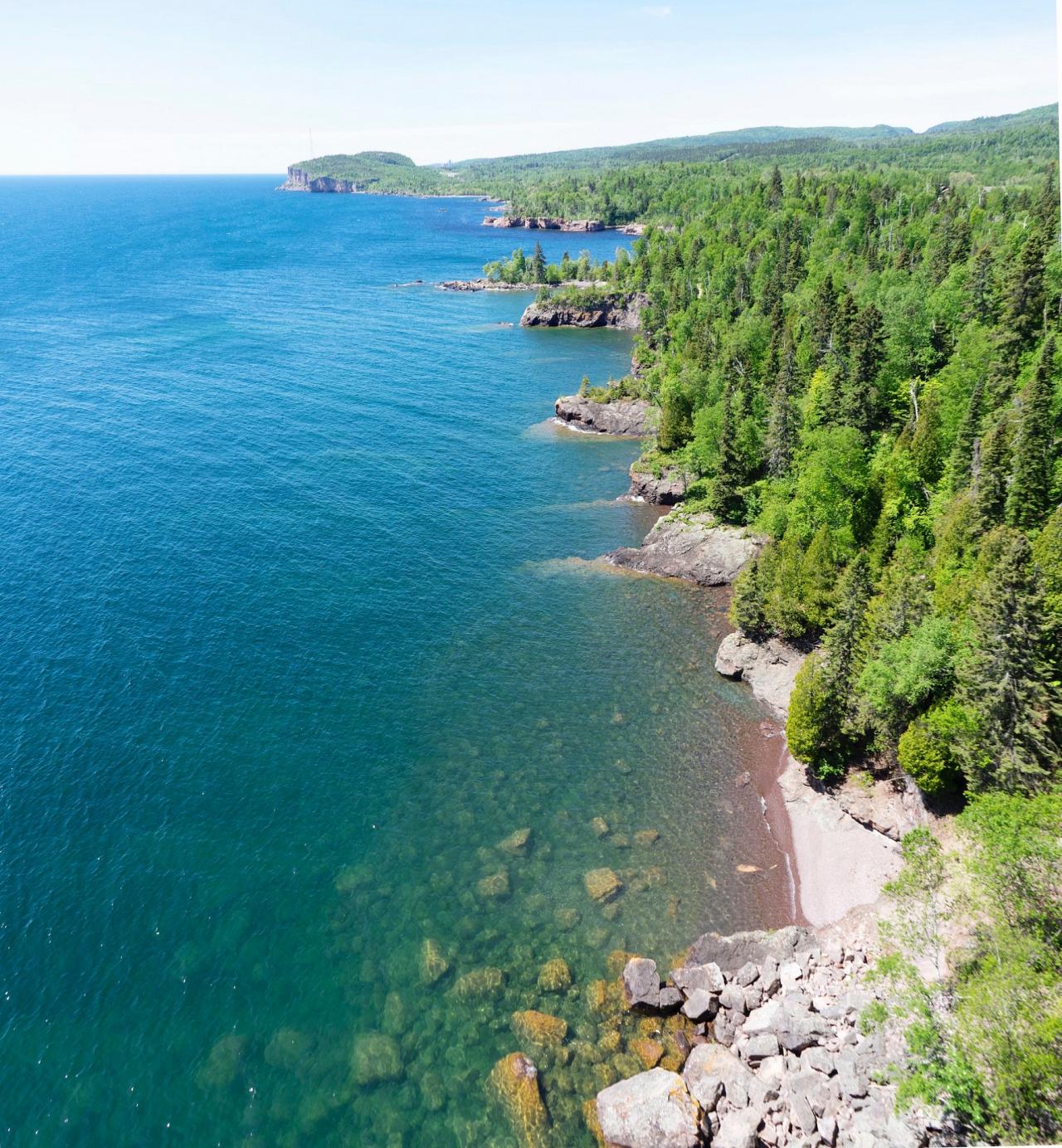
Cost of the Journey
Cost of the journey is $3890 DBL / $4790 SGL, from Duluth, MN. Cost of the Pre-Tour Extension is $1550 DBL / $1995 SGL. This cost includes: accommodations for 7 nights, all meals as specified in the itinerary, airport welcome and transfers, land transportation during the tour, professional guide services, park and other entrance fees, canoe fees, and miscellaneous program expenses. Cost does not include: round-trip airfare to and from Duluth, items of a personal nature such as laundry, telephone, drinks from the bar, or gratuities for luggage handling or personal services. Please note if you choose to combine our Michigan Isle Royale trip with this one, bridged by Wisconsin’s Apostle Islands extension, you earn a $300 per person discount for this grand slam trio along Lake Superior!
Please plan to make air travel plans only after the minimum group size has been met. We will send you a confirmation email as soon as the trip has been confirmed.
The airport for this tour is Duluth, Minnesota, and we will arrive in time for airport pickups after 2:00 PM on Tues, Sept. 7. You may leave at the time of your choice from Duluth on or after September 14.
Browse below for trip reports and species lists from past versions of this and other tours from this destination.
- Trip Report
- Species List
Bearskin Lodge & Boundary Waters

Dave is a naturalist with interests in birds, migration, ecosystems and natural disturbances, plants, and gardening. He holds a PhD from the University of New Mexico. Dave worked for The Nature Conservancy for 25+ years as Director of its Migratory Bird Program. He has researched in Latin American and the Caribbean. An avid birder, Dave enjoys teaching about natural habitats and local cultures. He has published papers in scientific and popular journals.
Other trips with Dave Mehlman
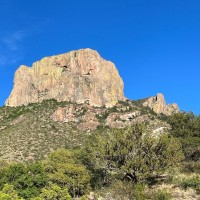
Essential Information +
This information is important for being prepared for your journey; we want you to have the best experience possible. If you only read one section, this one is key!
Ahead of Your Tour
- Please talk with your doctor about general health needs. It is a good idea to consult with your doctor about general vaccinations recommended for travel.
- Please plan to make air travel plans only after the minimum group size has been met. We will send you a confirmation email as soon as the trip has been confirmed. After you make travel reservations, please send a copy of your travel itinerary to the Naturalist Journeys office at [email protected] .
- Travel insurance in case of serious medical emergency is recommended. Full health coverage and repatriation is available through Allianz Travel Insurance .
- Soft sided luggage/duffel bags are easiest for packing the vans. Remember to pack essential medications in your carry-on luggage, as well as one day of clothing and optics in case of luggage delay.
Health Information
We will share a copy of your health and emergency contact information with your guide. This information will be kept confidential but is very important in case of a medical emergency. In addition to bringing any prescription medications with you, we recommend that you have a copy of the prescriptions in case of loss.
Pace of the Tour & What to Expect
You will receive a Schedule-at-a-Glance and list of hotels (our eContact List) a few weeks before your departure. This will serve as an outline for each day and alert you to any recent changes made in the schedule or to our hotels, if needed.
Our journeys are set up to follow the rhythm of nature. Our focus is on birding and nature; we offer full, well-planned field days and often get up early for that magical time around dawn. We generally follow the published itinerary, but we stay flexible to the weather, wildlife opportunities and the interests of the group. Your guide will keep you apprised of the next day’s schedule at each evening meal, noting what to bring and what to prepare for. Questions and/or concerns are welcome.
The pace of our Naturalist Journeys tours is moderate; to fully participate you should be able to get in and out of vehicles several times a day, and walk 1-3 miles over uneven terrain . It is important to participate with a flexible attitude as adjustments may be made in our schedule to make the most of our time in the field or for other purposes at your guide's discretion. We are not a “listing” bird company that drills down on target species, but at times we do wait for those special species unique to the places we visit. During the day, we take time to stop for photos and for educational opportunities to learn about conservation projects, landscapes, and geology. We appreciate other taxa as well as birds, with mammals often the biggest draw but plants and butterflies are also very popular. Our clients often lend their own expertise to the mix.
We like to make meals a fun and memorable part of the experience, too. Breakfasts are often at hotels, and we carry snacks, fruit, and water in the vans each day. Lunches are a mix of picnics in the field (weather dependent) and a chance to dine with locals at small cafes and restaurants. For dinner, we pride ourselves in our homework to keep up with the best choices for dining, choosing restaurants with atmosphere that specialize in local foods. On occasion we keep dinner simple to go back out in the field for sunset wildlife viewing or night walks. In some remote locations, our choices are limited. If you are tired, room service for dinner may be an option you can choose.
Food & Drink
We carry water and juices/cold drinks in the cooler each day, and sodas if people like them. Please also plan on bringing and filling your water bottle for hiking each day. We try to use as few plastics as possible!
Packing, Clothing & Laundry
Soft sided luggage/duffel bags are easiest for packing the vans. Please pack essential medications in your carry-on luggage, as well as one day of clothing and optics in case of luggage delay.
Dress is informal and is casual even at restaurants. Layering is a great way to stay comfortable. Protective clothing is essential, whether it be from sun, rain, cold, insects, or vegetation. You need closed toe shoes, and wear comfortable walking shoes with good tread. Hiking boots with good support for hiking and on rocky terrain can work well.
Spending Money
Many people ask how much to plan to bring as spending money. Part of that depends on how much you want to shop. Most shops will take VISA and MasterCard or American Express. Typical items people purchase include local souvenirs and T-shirts, caps, and natural history books. You may want to bring cash for drinks with dinner (if available) or smaller local purchases.
Expect the normal tipping protocol to apply for hotel maids and bar service. If at the end of the tour, you would like to show your appreciation to your guides, tipping is entirely appropriate but at your discretion. We hope that you will be pleased with all professional services. Gratuities for group meals are included. For your birding tour guide, we suggest $10-$15 per day per guest. Note that if there is more than one guide, this amount can be split among them.
Cell Phones & Internet Service
Wi-Fi and cell phone service are available in most US destinations, although there are some exceptions in remote locations. Wi-Fi is generally provided in all hotels, lodges, and restaurants you visit, at least in public areas. Please refrain from taking or making cell phone calls in the vehicles when traveling with other passengers unless it appears to be an emergency as this disrupts other guests – please plan cell phone calls on your own time.
Smoking is not permitted in any vehicle or in any situation where the group is participating in an activity together, such as a vehicle excursion or a guided walk. Please respect all designated smoking areas at hotels and restaurants.
Transportation
For this tour, your guides will drive travelers in either full-size or mini-vans or a combination of those two. We ask all attendees to please rotate your seating, so you ride with different drivers and alternate between front and back seats.
Photo Release & Sharing
We take many group photos and will share photos with the group. And after your tour, we will organize a chance to share photos via Dropbox or Google Photos. Please note that this is our policy and if you prefer to be excluded, we need to know ahead of your tour.
By registering for this tour, you agree to grant to Naturalist Journeys and its authorized representatives permission to record photos and/or video of your participation in the tour. You further agree that any or all of the material photographed may be used, in any form, as part of any future publications, brochures, or other printed materials used to promote Naturalist Journeys, and further that such use shall be without payment of fees, royalties, special credit or other compensation.
Please contact Naturalist Journeys by email at [email protected] or telephone our office: (520) 558-1146 or toll free: (866) 900-1146 if you have any questions. Many thanks for traveling with us and we hope you enjoy your journey.
Photo credits: Banner: Lakeshore at Cascade River, Naturalist Journeys Stock; Belted Kingfisher by Pete Nuij on Unsplash; Misty Lakeshore Morning, Naturalist Journeys Stock; Black Bear, Naturalist Journeys Stock; Lakeside, Naturalist Journeys Stock; Lakeshore at Cascade River, Naturalist Journeys Stock; Moose, Naturalist Journeys Stock; Boundary Waters Scenic by Dodie Logue; Cedar Waxwing, Steve Buckingham; Common Loon by Ray Hennessy on Unsplash; Lake Superior by Lucas Ludwig on Unsplash; Black-capped Chickadee, Doug Greenberg; Minnesota long crop, NJS; Belted Kingfisher by Pete Nuij on Unsplash; Spotted Sandpiper by Ryk Naves on Unsplash; Gunflint Trail by Samantha Gades on Unsplash; Cascade River State Park by Josh Hild on Unsplash; Lake Superior by Lucas Ludwig on Unsplash; Tettegouche State Park, by Josh Hild on Unsplash; Moose, Greg Smith; Lake Superior by Lucas Ludwig on Unsplash; Boundary Waters Canoe Area Wildnerness by dan carlson on Unsplash; Cedar Waxwing, Steve Bull; Common Loon, by Ray Hennessy on Unsplash; Gunflint Trail by Samantha Gades on Unsplash; Spotted Sandpiper by Ryk Naves on Unsplash; Tettegouche State Park, by Josh Hild on Unsplash.
Like what we do?
Sign up for our weekly enews to stay up to date, get to know our favorite destinations each week. we promise no spam..
NATURALLY AVIAN Birding Tours and Nature Photography

Welcome to Naturally Avian birding tours and nature photography!
Naturally Avian Mission Statement To inspire the conservation of natural resources
and promote the awareness and appreciation of natural beauty;
through birding tours, wildlife photography, and giving presentations to the public.


Sharp-tail Grouse Viewing
Experience Sharp-tail Grouse up close from a blind at the famous Gun Lake Blind located in Aitkin County. Watch dancing and displaying males on the lek as they compete for the females near-bye.

Guide Package 2
Info Coming Soon!

Guide Package 3
Newsletter sign up.
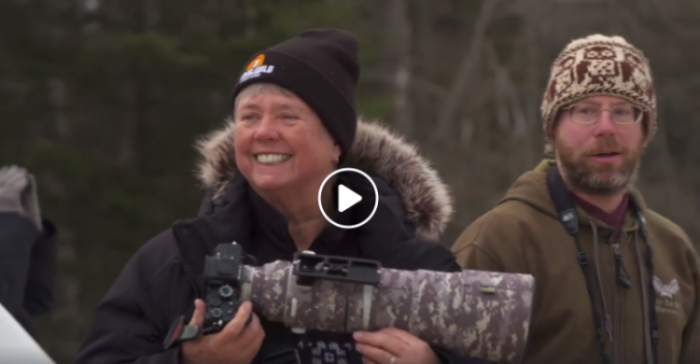
WDSE TV and PBS
Sax-zim bog, mn backyard birds.
Attract and enjoy colorful songbirds at your home or business with birdscaping. Together we can make your yard or property more inviting and attractive using native plants and the best bird feeders for our feathered friends.
With your help, we’ve protected 4,206 acres of Bog for future generations!

Birding the Bog

Find your way around
- Download 2024 Sax-Zim Bog Birding Map (jpeg)
- Download 2023 Sax Zim Bog Birding Map (pdf)
Latest Bird & Wildlife Reports
- Read the latest bird & mammal sightings here!
Start checking birds off…
- Download the Sax-Zim Field Bird Checklist (pdf)
Hire a BIRDING Guide (see below for Photography Tours)
Interested in hiring a guide? The Friends of Sax Zim Bog recommends contacting:
KYLE TE POEL — Next Bend Birding Tours Professional naturalist-led tours in Minnesota and nationwide since 2008
Year-round tours in the Sax-Zim Bog, throughout Minnesota, and nationwide. I’m a professional naturalist with a Masters in Education, whose resume includes the Sierra Club, Minnesota Audubon, National Audubon Society, Project Puffin, Minnesota State Parks, National Park Service, and guiding at bird festivals around the country. My knowledge and interests are wide-ranging, ensuring tours are informative and fun for all ages and experience levels. Communication and customer service are top notch from first contact to the end of the tour. Next Bend was awarded “Gold” status (the highest certification) by the Green Business Directory for personal and professional sustainability practices. I support several conservation organizations, and donate 10% of my gross income from Sax-Zim tours to the Bog’s “Acres for Owls” land preservation project. I’ll work with you to create a customized tour based on your wish list and schedule, while providing several perks free of charge. Featured in local, regional, and national publications and television. I am fully vaccinated and boosted against COVID-19.507-358-8810 (call or text) [email protected] https://kyletepoel.crevado.com/minnesota-birding-guide (reviews at bottom of page!) Trip Advisor and Google profiles (search Next Bend Birding)
https://www.facebook.com/NextBendBirding / Instagram (@nextbendbirding)
GREGG SEVERSON (Sax-Zim and Twin Cities; Birding Bike Trips, Birding & Beer Bus Trips)
Gregg loves birding, and also spending social time with other birders and naturalists. He is excited to share the exceptional birds and other wildlife of Sax-Zim and the rest of MN with his clients. He was a guide for the Sax-Zim Winter Birding Festival for many years and loves to vicariously experience other birders’ lifer highs! Gregg mostly guides Friday-Sunday, in every season. He takes lots of photos with his Canon P900 and has a special interest in audio recordings of birds. Gregg co-organizes MN Global Birding presentations and happily discusses international birding. Feel free to ask about recommendations for good breweries, cideries, and distilleries in the area, as well as other cultural or natural attractions. Fully vaccinated and boosted against COVID-19. 612-568-5272 (call or text) [email protected] www.BirdingwithGregg.com https://www.instagram.com/birdingwithgregg/
KIM RISEN—Naturescape Tours [email protected] www.naturescapetours.com 218-426-3926 218-839-0517 (call or text)
CLINTON DEXTER-NIENHAUS (Friends of Sax-Zim Bog Head Naturalist) Limited guiding availability; Larger groups (5 or more) only, with 4 hour minimum.
Guiding not limited to birds! All parts of the natural world considered.
Contact Clinton at [email protected] for rates, field trip options, and availability.
FRANK NICOLETTI [email protected]
ERIK BRUHNKE [email protected] www.naturallyavian.com 262-408-8892 (call or text) **10% of Erik’s gross from guiding in Sax-Zim Bog will be donated to Friends of Sax-Zim Bog
JUDD BRINK (Sax-Zim Bog, Aitkin County, Brainerd Lakes area)
Availability: All seasons for Sax-Zim Bog. Aitkin County, Brainerd Lakes Area available upon request year round. Guiding experience: 12 years with the birding festival and private guiding at Sax-Zim. Feeding and watching birds/wildlife for over 30 years in Minnesota! Have a B.S. in Natural Resources Management, Owner/Guide of MN Backyard Birds (Birdscaping), President of Bee-Nay-She Bird Council, Board Member of Brainerd Audubon Society, Master Naturalist, Minnesota Ivory Billed Woodpecker Research Team in 2011, involved with a National Geographic filming project on Great Gray Owls for their Voyagers series. Traveled/Birding ( Alaska, Costa Rica, Iceland and Ecuador in 2022!) Attended the World Owl Conference (first time to be hosted in the USA) LaCrosse, WI. October 2023.
[email protected] www.birdmn.com 218-838-4784 (call or text)
**Video link below of Judd in action guiding in the Sax-Zim Bog [starts at 6:56 in the episode]:
Judd Brink guiding segment on PBS show Making it Up North
Interested in a Wildlife Photography Tour or Workshop? Check out these companies/guides
Click HERE to go to Wildlife Photo Tours page
FOSZB Bird Feeding Station Statement
Friends of Sax-Zim Bog has created bird and mammal feeding stations at the Welcome Center/Gray Jay Way, Winterberry Bog, Fringed Gentian Bog , Yellow-bellied Bog and now Admiral Road . These are the only feeding stations we manage in Sax-Zim Bog. The placed food is carefully selected and benefits the birds, but the feeders also benefit all visitors who enjoy watching and photographing our boreal wildlife.
We will actively monitor all bird feeding stations associated with our FOSZB properties to ensure a safe and ethically-minded environment is maintained for all wildlife. Friends of Sax-Zim Bog reserves the right to take any and all appropriate action at our bird feeder stations if conditions arise which may jeopardize safety of the birds and mammals utilizing them. As a land preservation organization, we value visitor experiences at our properties but must balance this with our responsibility to the land and its inhabitants.
*We ask visitors to not place any bird feed in any of our feeders on FOSZB properties. We have staff and volunteers who fill our feeders with approved bird food. In lieu of donating bird seed, please consider making a designated donation via our website or at the Welcome Center. The one exception is placing human-grade peanut butter at the Admiral Road feeding stations. This is allowed.
FOSZB BIRD/WILDLIFE FEEDING STATION GUIDELINES
FOSZB GOALS IN MAINTAINING BIRD/MAMMAL FEEDING STATIONS IN SAX-ZIM
- To attract birds and mammals for visitors to enjoy and photograph.
- To help supplement the natural diet of many bird and mammal species, especially the irruptive winter finches such as Evening Grosbeaks, Pine Grosbeaks, Common and Hoary Redpolls, Purple Finches.
- As an education tool for sharing natural history with visitors.
FEEDER PLACEMENT & FILLING
- Feeders will be clustered at FOSZB parcels to minimize impact on the Bog and facilitate easier filling.
- In most cases feeders will be clustered near trailheads and start of boardwalks to minimize any chance of invasives.
- Only FOSZB staff or volunteers are officially allowed to fill feeders
BIRD/WILDLIFE FEED
- Only seed purchased by FOSZB will be used in FOSZB feeders
- We will only feed human-grade peanuts and peanut butter
- Peanut butter (if used) will only put out December through February (and should be removed if a prolonged warm spell prevails…e.g. temps above freezing for 48 hours or more). [*human-grade peanut butter is endorsed for cold season feeding by Audubon, Cornell, Laura Erickson, Julie Zickefoose]
- Peanut butter—We will not feed peanut butters that have Xylitol in the ingredients. It’s highly toxic to dogs, and may not be healthy for birds (per Laura Erickson).
- Peanuts and peanuts in the shell must be food-grade to avoid aflatoxins
- Use homemade “bark butter” instead of peanut butter when possible (lard, cornmeal, peanut butter, oatmeal). Bark butter is only to be used December through mid March.
- Sunflower seed and nyjer (thistle) unused by the end of the winter season will be dumped out at an appropriate site (sunflower seed shells are a plant growth inhibitor so may not be appropriate for composting)
- Check expiration dates for all seed purchased
- Cracked corn—If used we will not purchase in non-breathable plastic bags due to aflatoxins not (per Laura Erickson)
- We will not feed bacon fat or other congealed drippings due to harmful sodium nitrates (per Laura Erickson)
- All deer rib cages must come from within the deer hunting zone that Sax-Zim is in (to avoid any spread of CWD per MN DNR).
- All deer rib cages will be inspected with a metal detector for any metal fragments prior to feeding.
END OF WINTER SEASON
- All feeders must be taken down by March 31 (due to bears and the destruction they can cause). This date may be altered if we experience a very early spring.
- Any remaining deer rib cages will be removed and disposed of by May 1.
- Thoroughly clean all feeders after the winter season and store after completely dried.
- Clean feeders using bleach, brushes, soapy water, etc.
- In spring we will clean up ground spill from feeders and dispose of properly (compost at WC?)
- Thorough ground cleaning and general “tidying up” at all feeding sites.
SUMMER FEEDING
- Only using hummingbird feeders at Welcome Center (at this time)
- Hummingbird feeders will be cleaned monthly
- Sugar-water will be refrigerated if made well in advance of putting in feeders
- No red dye added to sugar water
- No seeds or suet or rib cages in summer
- Jelly in spring? Probably not due to bears
DONATIONS OF SEED FROM THE PUBLIC
- FOSZB prefers that visitors make cash donations in lieu of donating seed
Birding/Photography Etiquette reminder
First of all, this is YOUR Bog! It is not our Bog. And we all want to have a pleasant experience here.
The majority of the Sax-Zim Bog is public land (County, State, etc) with many private lands as well. Friends of Sax-Zim Bog owns and manages over 4,000 acres on nine tracts.
We are NOT the police of the Bog. Everyone must take responsibility for their own behavior. Much of this is just common sense and common courtesy.
BE A FRIEND OF WILDLIFE
- WELFARE & SAFETY OF ALL WILDLIFE COMES FIRST…OUR PHOTO/VIDEO COMES SECOND! EVERY TIME.
- Use common sense to not unduly disturb wildlife.
- Winter is a tough time for all critters, so avoid interrupting their survival strategies. All wildlife needs food (calories) and rest. (e.g. don’t repeatedly disturb a critter as it tries to hunt and get calories; don’t throw things at a critter so it looks at you or flies; do not tease owls with fur on a a string or a mouse in a cage…the owl spends energy with no caloric reward; avoid disturbing roosting nocturnal species which are sleeping; don’t harass wildlife with a drone.)
- Speeding after fleeing wildlife in your car is a bad idea. The critter is expending valuable calories by running at top speed.
BE A GOOD NEIGHBOR
- Watch your rear view mirror when driving the roads…Please pull over so others going faster can safely pass…especially snow plows.
- When you do stop to observe or photograph wildlife, etc, please pull over to the side of the road (But be careful in winter that you don’t pull over too far and get stuck in the ditch!)
- Do not pull over and park across from another parked vehicle. The space between the two cars is usually too narrow for other traffic to get through at normal speeds.
- Avoid pointing binoculars and scopes and cameras at any dwelling. How would you like it if you looked out your picture window in the morning and saw folks staring at you?
- Private property is private property. Do not step on any land unless you know it is public land.
BE KIND AND COURTEOUS
- Respect other visitors and locals.
- If someone is already watching/photographing an owl or other wildlife, stay back…stay behind them and remain quiet. They were there first. Or ask if you can join them.
- Keep voices low when a group is watching/photographing a bird or mammal.
- Turn off your car engine when observing wildlife or feeders at close range.
- Don’t walk in front of those watching/photographing wildlife.
Let’s all use common sense and common courtesy and have a good time out there! The Sax-Zim Bog is a wonderful place full of amazing “bogdiversity” that is ours to discover and enjoy.
Here are some other links to Ethics Statements on wildlife/bird viewing/photography from other conservation groups:
North American Nature Photography Association
American Birding Association Code of Birding Ethics
Audubon’s Guide to Ethical Bird Photography
Wildlife Viewing Guidelines Yellowstone National Park
- Birder's Guide to Minnesota
- MBW Registration
- Birding by Hindsight
- Minnesota Sewage Ponds
- Guiding Services
MINNESOTA BIRDING WEEKS
APRIL 2023 - FEBRUARY 2024
~ Our 35th (and Final) Season ~
T HERE ARE NO MBWEEKS SCHEDULED FOR 2024-25
OR SUBSEQUENT SEASONS; HOWEVER, MBWEEKENDS
WILL CONTINUE THROUGH THE 2025-26 SEASON.
Santa Margarita Ranch, Starr County, Texas (Jerry Pruett photo)
Minnesota Birding Weeks (MBW) scheduled another season of unique, modestly priced, out-of-state birding trips – our 35th and final year . (There were no MBWeeks in three seasons during our 38-year history of MBWeekends.) After so many years, we have had a total of over 125 MBWeeks with about 1,400 participants, and a composite list of 732 species .
Please visit the MBWEEKENDS page for information on the shorter in-state MBWeekends – which will continue for two more seasons.
MINNESOTA BIRDING WEEKS
• APRIL 18 - 26, 2023 – HIGH ISLAND & TEXAS HILL COUNTRY •
CLICK HERE for the summary of this MBWeek
• JUNE 3 - 11, 2023 – BLACK HILLS & WESTERN DAKOTAS •
• JULY 22 - 30, 2023 – SOUTHEAST ARIZONA •
• JANUARY 13 - 21, 2024 – SOUTHERN CALIFORNIA •
• FEBRUARY 6 - 14, 2024 – SOUTH TEXAS •
CLICK HERE for summaries of this MBWeek

INTERNATIONAL TRIPS
I organize trips to international destinations to get to know the birds and culture of other countries. Our next trip is to Honduras in March of 2025.
GUIDED BIRDING
I will guide you on a half-day, full-day, or multi-day birding adventure, including in the famous Sax-Zim Bog birding area!
Contact me about birding opportunities!
Check out these recent posts from my instagram feed:
Guided Bird Watching Tours
Minnesota Valley Wetland Management District
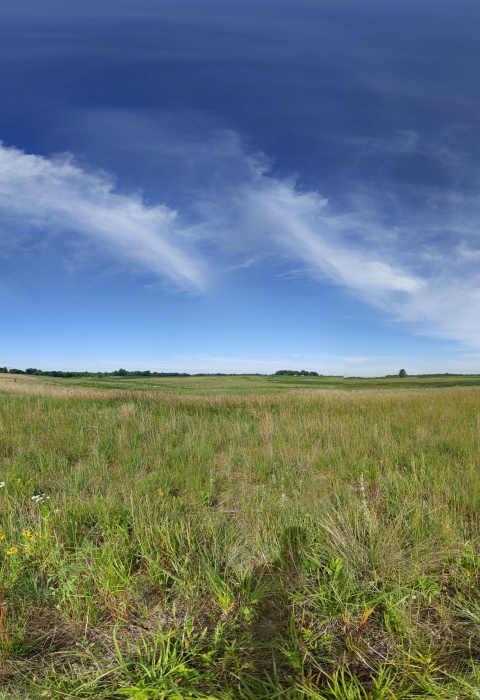
Facility Activities
Many opportunities for enjoying nature can be found on Minnesota Valley Wetland Management District. Non-consumptive activities are highly recommended (e.g. wildlife viewing, photography, hiking, and education, etc.), and traditional wildlife dependent recreation (e.g. hunting, trapping, and foraging) is available per state and federal regulations as well.
The district's 10,000 acres of grasslands and wetlands attract many types of shorebirds, waterfowl, and songbirds as a stopover on their migration route between their breeding grounds further north and their wintering areas in the south. Annually, over 250 species of birds can be...
Cross-country skiing is allowed on waterfowl production areas, however there are no groomed trails. For your safety, please avoid wetlands as some of them do not freeze solid in the winter and may contain thin ice.
Dogs on 6-foot leashes are allowed to enjoy the waterfowl production areas with their owners. Visitors should use disposable dog waste bags to remove all solid pet waste when visiting. Dogs may be off leash only when actively hunting. Dog training is not allowed on waterfowl production...
Waterfowl production areas are open to fishing per state regulations unless specifically prohibited or posted. Be sure you are also familiar with district-specific regulations when you plan your visit to go fishing. No motors are allowed on district waters. Major species include crappie,...
Although there are no trails on waterfowl production areas, visitors are welcome to hike unless otherwise posted.
The district offers public hunting on over 30 waterfowl production areas located in a 14-county area of east-central Minnesota, many within easy driving distance of Minneapolis and St. Paul. Unless otherwise posted, or specifically prohibited, waterfowl production areas are open to all hunting...
Whether you wield a smartphone or a zoom lens, you’ll find photo-worthy subjects at national wildlife refuges and wetland management districts. Waterfowl production areas provide visitors with ample opportunities to observe and photograph wildlife and scenery. Many species of waterfowl,...
Picnicking is allowed on the wetland management district, however there are no formal picnic facilities. Please plan to pack out any trash or recycling after you are done enjoying your picnic.
Snowshoeing is allowed on waterfowl production areas. For your safety, please avoid wetlands as some of them do not freeze solid in the winter and may contain thin ice.
Waterfowl production areas are open to trapping per state regulations. Please see the Minnesota Department of Natural Resources Trapping & Furbearers page for more information and links to regulations and license information.
Foragers may enjoy picking mushrooms or berries on the district. There are limits to what you can take, and we recommend checking our regulations before your search. Reminder: Some mushrooms and berries are poisonous - if you are unsure, don't eat!
Visitors...
Waterfowl production areas are great places to experience nearby nature. You can discover hundreds of species of birds, numerous plants, mammals, reptiles, and insects during your visit. Waterfowl production areas are great places to view numerous species of waterfowl, shorebirds, and songbirds...
You are exiting the U.S. Fish and Wildlife Service website
You are being directed to
We do not guarantee that the websites we link to comply with Section 508 (Accessibility Requirements) of the Rehabilitation Act. Links also do not constitute endorsement, recommendation, or favoring by the U.S. Fish and Wildlife Service.

IMAGES
COMMENTS
Owls and Winter Birding in the Boreal Forest of Minnesota January 2025 . In true winter wonderland fashion, Minnesota offers picturesque scenes of snow-covered evergreens and iced-over lakes. This short Minnesota birding tour focuses on a variety of birds that use Lake Superior and the boreal forest as their winter homes.
This is what makes Minnesota, and Sax-Zim Bog, one of the greatest birding adventures to be found in the United States. Well, and also the amazing bird species. The possibility of seeing four incredible owl species - Great Gray Owl, Boreal Owl, Northern Hawk Owl, and the majestic Snowy Owl! Best Season: Winter, Early Summer.
March 2024 - January 2025 MBWeekends ~ Our 39th Season ~ • Minnesota Birding Weekends • Minnesota Birding Weekends continues to offer unique, modestly priced weekend (and weekday) birding tours throughout Minnesota since we originated in 1986. Since then, we've had more than 9,000 registrations (MBWeeks included), over 450 MBWeekends, and a composite list of 371 species seen in the state.
Audubon Minnesota has three online birding trail guides to introduce you to these places: Minnesota River Valley Birding Trail Guide. Great River Birding Trail Guide -- Headwaters to the Minnesota-Iowa Border. North Shore Birding Trail -- Birding Minnesota's North Shore of Lake Superior from Duluth to Grand Portage. Each online interactive map ...
Highlights of MINNESOTA: Winter Boreal Specialties. Brilliant Boreal Birding! 7 owl species *possible* including Great Gray, hawk owl, & Snowy Owl. Spruce Grouse, Sharp-tailed Grouse, Ruffed Grouse, & Wild Turkey. Pine Grosbeak, Evening Grosbeak, crossbills, & both redpolls. 4 nights, 1 hotel - unpack & relax!
Call 1-866-547-9868 (US or Canada) or (01) 520-320-9868 or click here to email. * Tour invoices paid by check carry a 4% discount. Details here . Maximum group size seven with one leader. WINGS Birding Tours to Minnesota in Winter - Itinerary. WINGS is a worldwide birding tour company based in Tucson, Arizona.
Single supplement: $450. This is a birding tour, designed to see as many bird species as possible, with special focus on specialty species. Northern Minnesota's Sax Zim Bog draws birders in for a chance to see the highly sought after Great Gray Owl and Northern Hawk Owl. In addition to these amazing owls, several boreal species such a Canada ...
2024 Narrative. In Brief: The expansive bog lands, boreal forests, and Lake Superior shorelines of Duluth, Minnesota and environs offer a uniquely accessible opportunity to see specialty birds of the northern climes in winter. Because of the nature of the boreal ecology, being comprised of relatively few species, the presence and abundance of ...
Tour 1 (weekend tour) February 6-10, 2025 Price: $2095 per person sharing Single room supplement: $390 Guide: Adam Sell Maximum of 7 participants ... sax-zim bog and northeast Minnesota in winter. ... Our itineraries usually show minimal changes between years, but some substantive updates can occur as birding access and information evolves. For ...
PACE OF THE TOUR: At this time of year at this northern latitude the sun rises relatively late (approximately 7:30). We may have to drive as much as an hour and a half to reach our first birding stop of the day, however, so we'll rise early enough to factor in driving time.
For more information about birding and other outdoor recreation opportunities, subscribe to the monthly Minnesota Outdoors newsletter. Katie Koranda is a writer and photographer with experience at two of the nation's top public radio stations, newspapers, a global nonprofit, and a Fortune 100 company.
PHOTOGRAPHY: While this is a birding tour, Minnesota in winter offers many opportunities for taking excellent photos of most target species, from Gray Gray and other owls to Spruce Grouse, and winter finches coming into the feeders. Because the list of target species is low, we often spend more time with individual birds, so this trip is more ...
Minnesota during winter may not sound much like a birding destination, but it is one of the best-kept birding secrets. Every winter northern owls - Snowy, Great Grey, Northern Hawk and Boreal Owls. 1-888-990-5552 [email protected]
September 7 - 14, 2021, w/Wisconsin's Apostle Islands extension. Join us for an extraordinary immersion in North Woods nature timed for the first hints of fall color and fall songbird migration. Discover boreal birds, search for iconic northern species such as Common Loon, Moose and Beaver, canoe and explore in the Boundary Waters Wilderness ...
Kim began leading birding trips around the Midwest while still in high school. As his experiences grew, so did his tour-leading schedule. As a result, for the last 31 years Kim has led birding tours throughout the United States, Canada, Mexico, Central and South America, and Southern Africa. For the past 25
Welcome to Naturally Avian birding tours and nature photography! and promote the awareness and appreciation of natural beauty; through birding tours, wildlife photography, and giving presentations to the public. Be sure to check out Naturally Avian on Facebook! Naturally Avian Birding Tours, based out of Duluth, Minnesota. Led by Erik Bruhnke.
Sharp-tail Grouse Viewing. Experience Sharp-tail Grouse up close from a blind at the famous Gun Lake Blind located in Aitkin County. Watch dancing and displaying males on the lek as they compete for the females near-bye.
Professional naturalist-led tours in Minnesota and nationwide since 2008. Year-round tours in the Sax-Zim Bog, throughout Minnesota, and nationwide. ... Gregg co-organizes MN Global Birding presentations and happily discusses international birding. Feel free to ask about recommendations for good breweries, cideries, and distilleries in the area ...
Traveling to Minnesota in the depth of winter may seem to defy reason, but for the birdwatcher, the season and place combine to produce a mouth-watering array of species. Northern owls always inspire the greatest interest; we'll look for Snowy, Great Gray, and Northern Hawk Owls, and if we're...
Minnesota Birding Weeks (MBW) scheduled another season of unique, modestly priced, out-of-state birding trips - our 35th and final year. (There were no MBWeeks in three seasons during our 38-year history of MBWeekends.) After so many years, we have had a total of over 125 MBWeeks with about 1,400 participants, and a composite list of 732 species.
CONTACT. Contact me about birding opportunities! Check out these recent posts from my instagram feed: Birding with Gregg - a Minneapolis-based bird guide offering birding and taproom tours and guiding in the famous Sax-Zim Bog birding area.
Birding Minnesota Guided Bird Watching Tours Main Menu. Home; About; Tours; Gallery; Contact; Blog
Tour Manager: Sara Pike. Call 1-866-547-9868 (US or Canada) or (01) 520-320-9868 or click here to email. * Tour invoices paid by check carry a 4% discount. Details here . This tour is limited to seven participants with one leader. WINGS Birding Tours to Minnesota and North Dakota - North Woods to Prairies - Itinerary.
Minnesota Valley Wetland Management District, established in 1988, is a 14-county district located in the transition zone between northern tallgrass prairie and eastern deciduous forest. It manages more than 10,000 acres of grassland and wetland habitat for the benefit of wetland and grassland dependent species.